We may receive a commission when you use our affiliate links. However, this does not impact our recommendations.
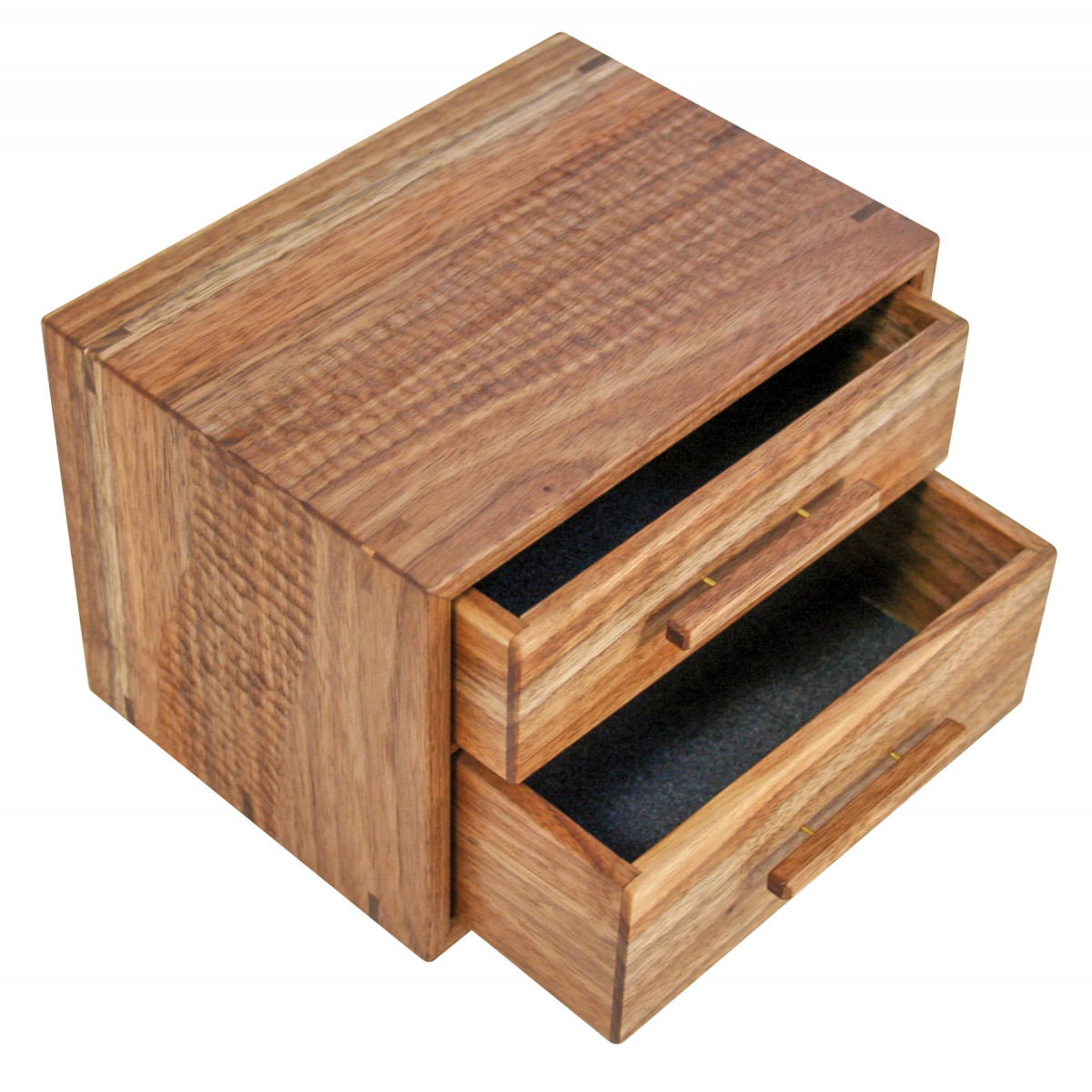
Turn a single board into a heirloom.
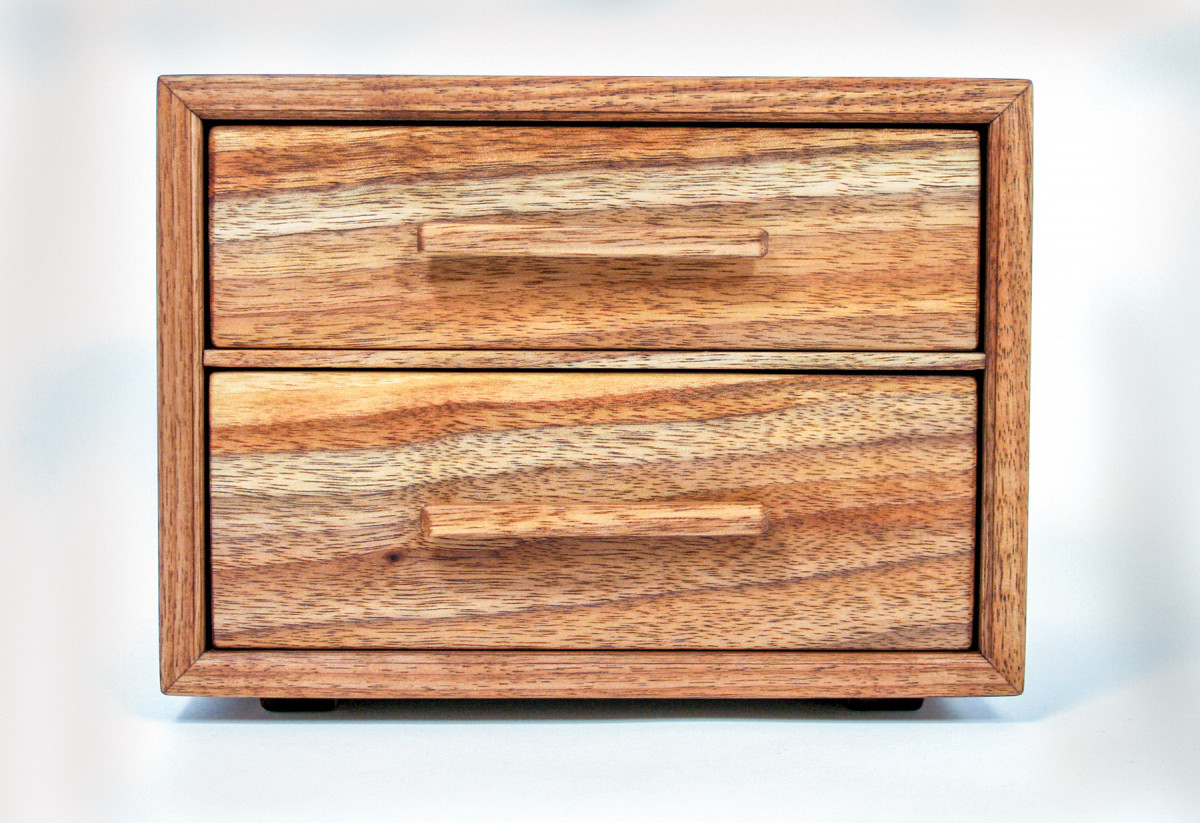 Jewelry boxes are some of my favorite pieces to make. There is so much versatility in the design and use! And, they give you a taste of all kinds of woodworking processes (though on a smaller scale).
Jewelry boxes are some of my favorite pieces to make. There is so much versatility in the design and use! And, they give you a taste of all kinds of woodworking processes (though on a smaller scale).
 This project is a quick and easy way to make good use out of one board of wood. With relatively simple joinery, this is a cost-effective piece to make in batches for sales or gifts.
This project is a quick and easy way to make good use out of one board of wood. With relatively simple joinery, this is a cost-effective piece to make in batches for sales or gifts.
Grain Selection & Layout
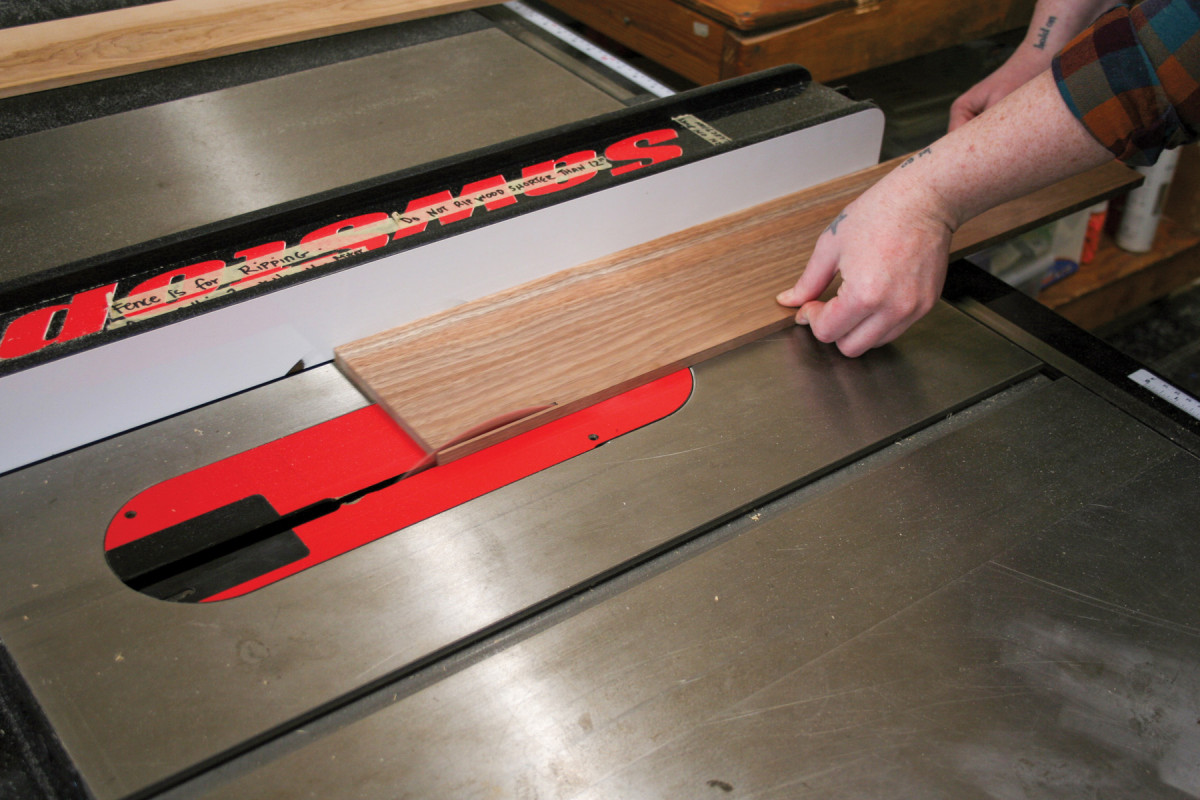
1. Begin by ripping your 3/8″ stock to 51/16″ wide. Even though you’ll be breaking this board down into four pieces, keep it one piece (26″ long) for the time being.
When you are inspecting a piece of wood for this project, think about grain selection—what do you want to be the outside of your box? What do you want the drawer fronts to look like? I like to roughly draw out on a piece of paper exactly where each piece on the cut list will come from so I know I haven’t overlooked any pieces.
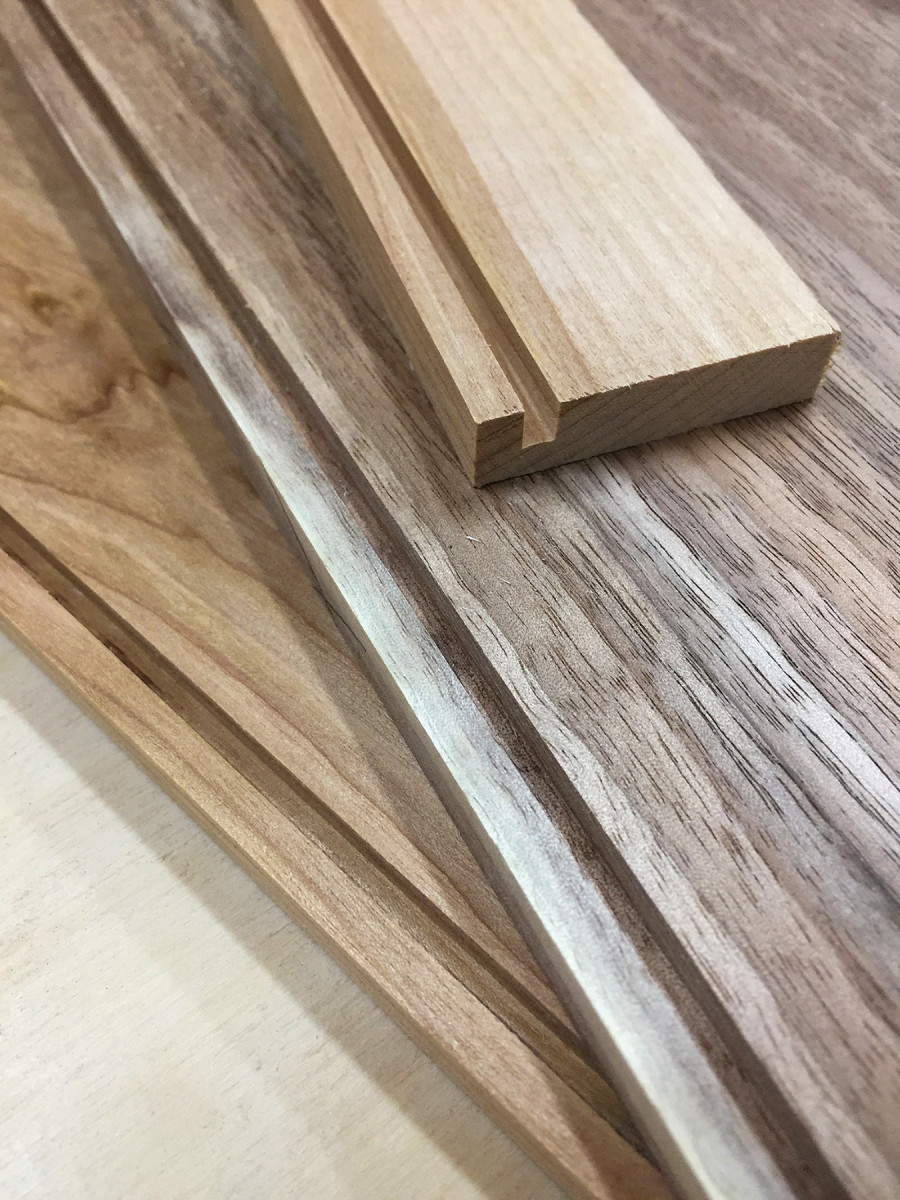
2. Next, cut a 3/16″ deep, 1/8″ wide groove 3/16″ from the back edge of the board. This will house the back.
I picked a nice clear section of grain to use for the carcass—being sure to label what side I want facing out. Since we will be milling the wood thin, you will want to keep your pieces in longer sections and ensure you have extra for things like drawer handles and splines. It is not fun to get nearly finished with and realize you need another 3“ of something. Lay out extra material to test saw set-ups on wood of the same dimension.
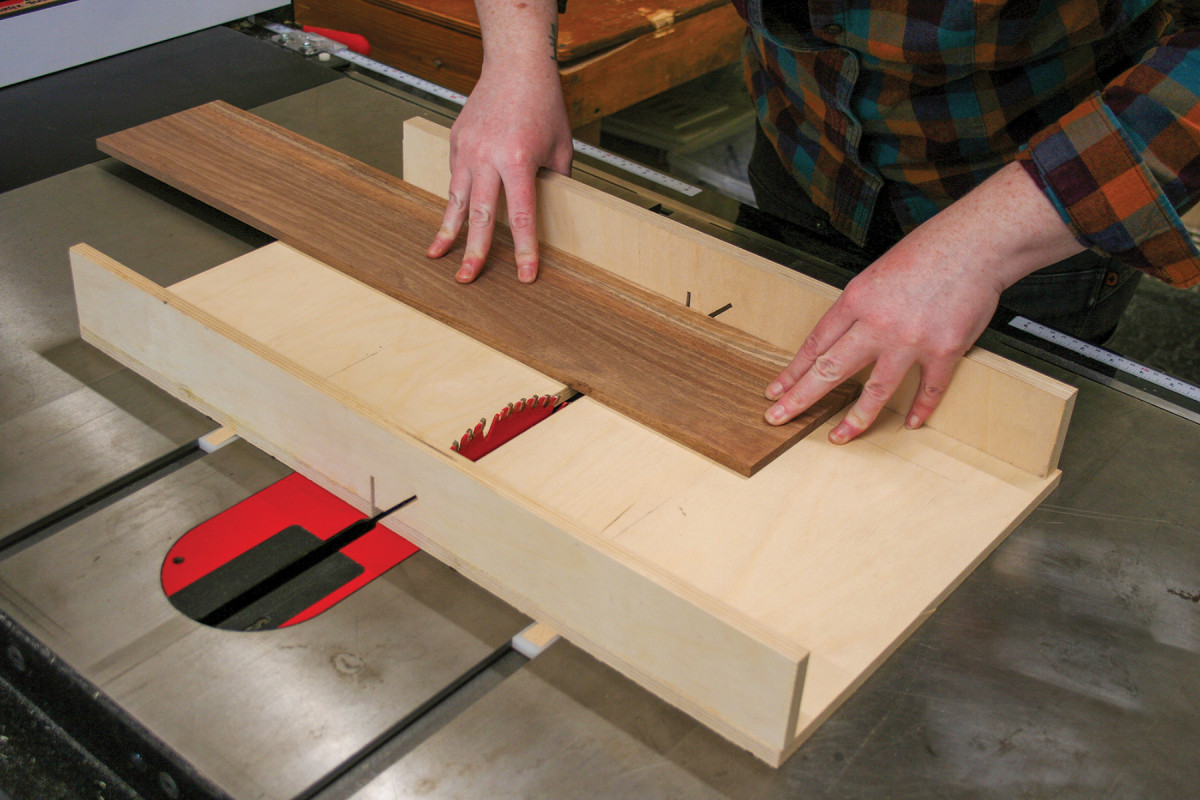
3. Use a crosscut sled to cut the carcass pieces to length on the table saw. Start by squaring up one end.
When working with thin stock, it is best to leave everything rough-milled to be slightly thicker than needed and stack the boards between stickers to prevent warping. Resawn lumber especially likes warp and twist after opening up. Ideally, you would mill your wood and cut joinery in the same day.
Cutting the Carcass
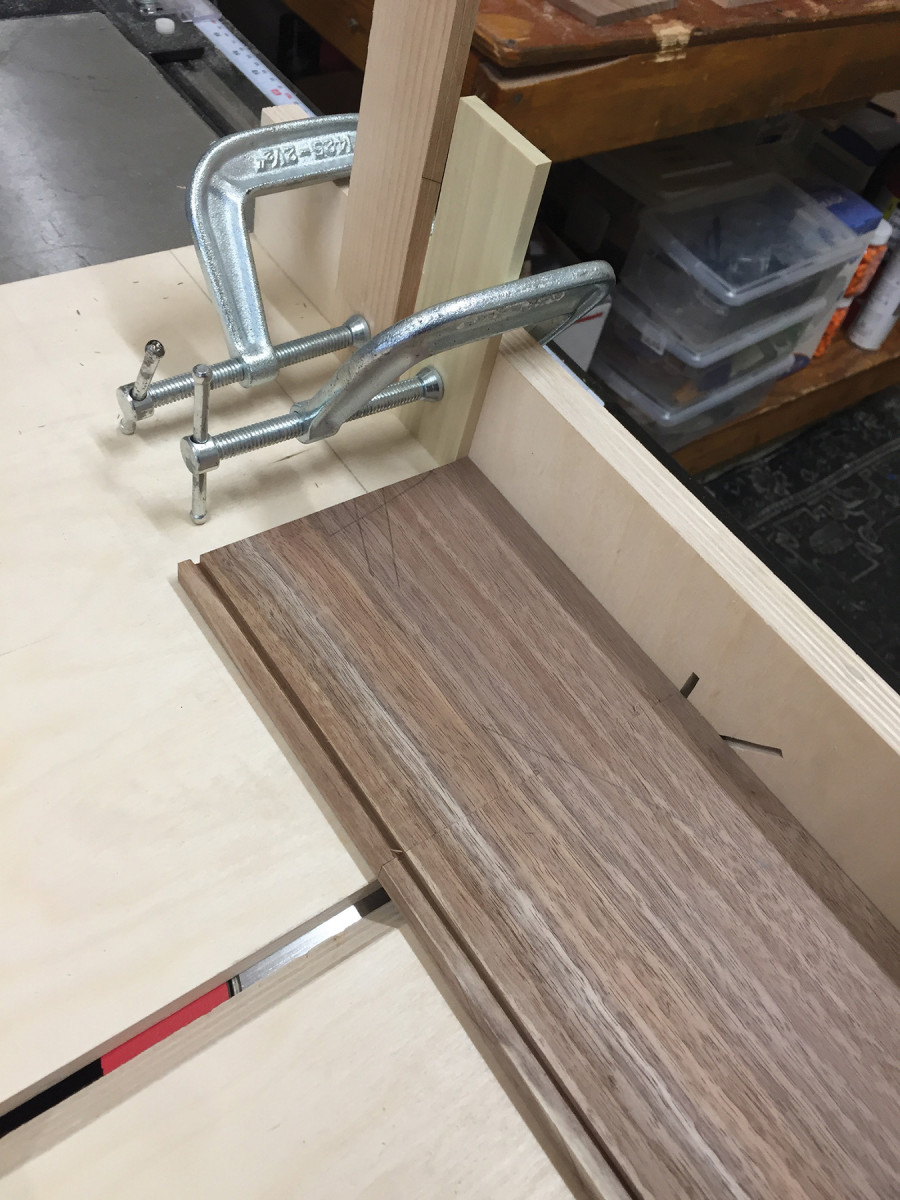
4. Use two stop blocks (one set at 71/8″ and one at 51/8″) to keep the top/bottom and sides consistent. You’ll be swapping out the 51/8″ block as you cut, to keep the grain continuous.
We’ll start with the carcass piece, milled to 3/8“ thickness, and the pieces for the back and shelf, milled to 1/8“ thickness. Rip the carcass piece to 51/16“ wide but keep at the 25-26“ length.
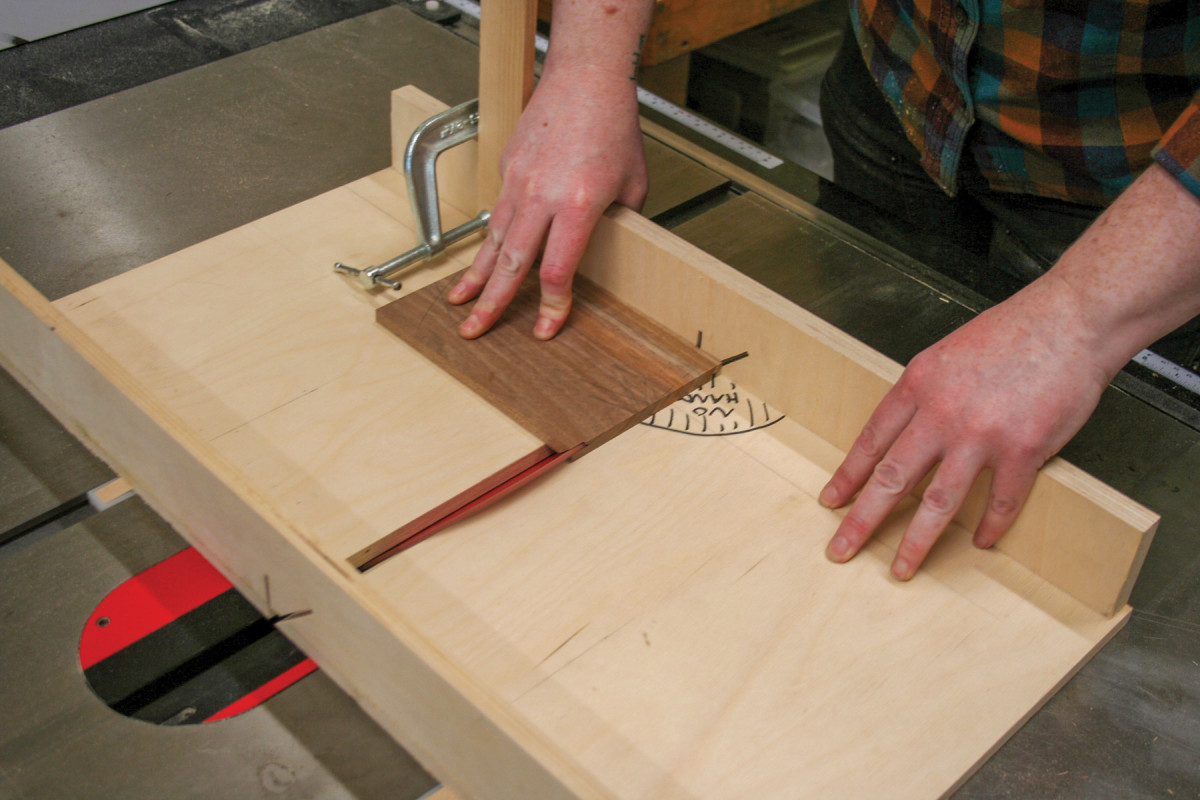
5. Set the blade to 45° to cut the miters. Use the stop blocks, cut the top and bottom, then the sides.
To cut the groove that will hold the back piece, I’m using a table saw with a flat-topped saw blade. Drop the height of the blade to 3/16“ and adjust the rip fence to 3/16“. Run the bottom edge of the piece along the fence and the inside of the piece down against the table to cut a groove. Test both of these settings on a piece of scrap wood before cutting into your final piece.
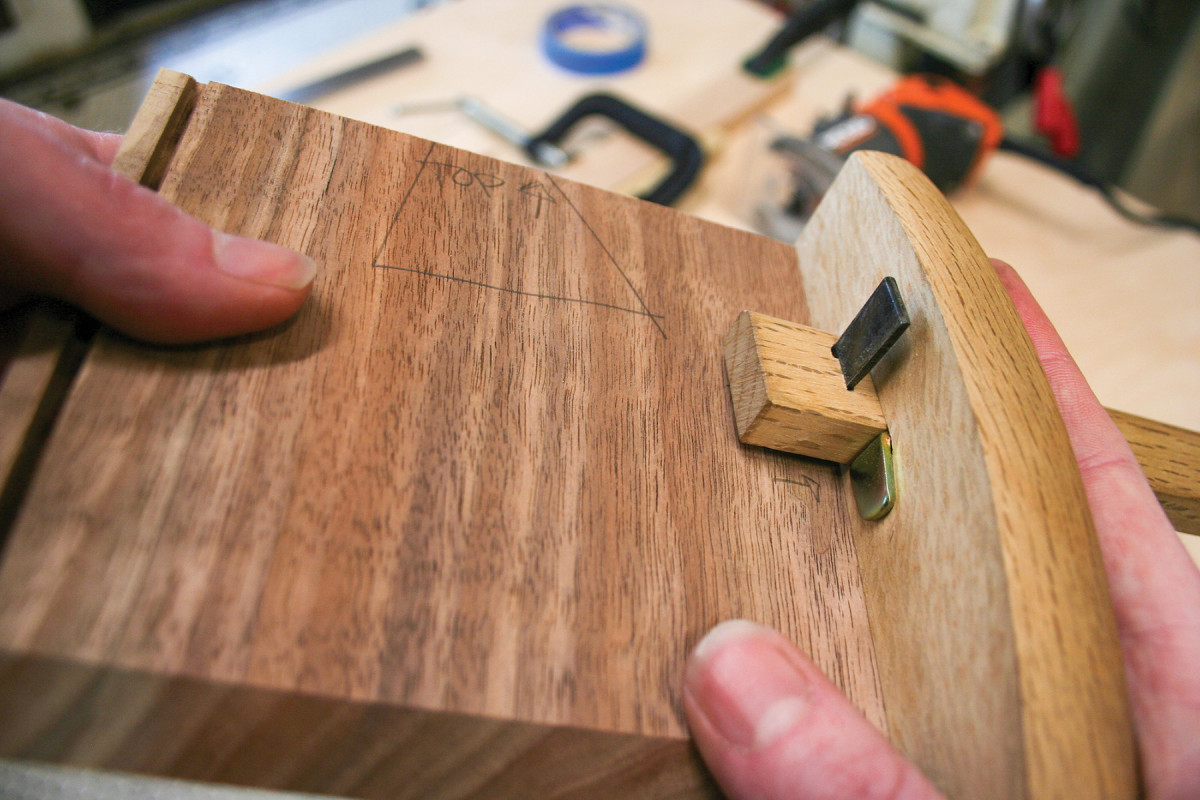
6. Use a marking gauge to mark the end of the stopped dadoes on the interior of the sides.
Set up a miter sled on the table saw to cross-cut the carcass pieces into the four lengths, at 90° for now. Mark the outside face of the board with triangles or lines to help line up the grain after the piece has been cut into shorter lengths. First, cut the very end of the board off to square it up, and then use that cut end against the stop block. Working on the right-hand side of the sled, set a stop block and cut the first piece to 71/8“. Leaving your first block in place, set a second stop block and cut the next piece to 51/8“, removing this stop block after this cut. Cut another piece at 71/8“ using the first stop block. The remaining piece will be your last 51/8“ piece which you can leave long for now.
Cut the Miters
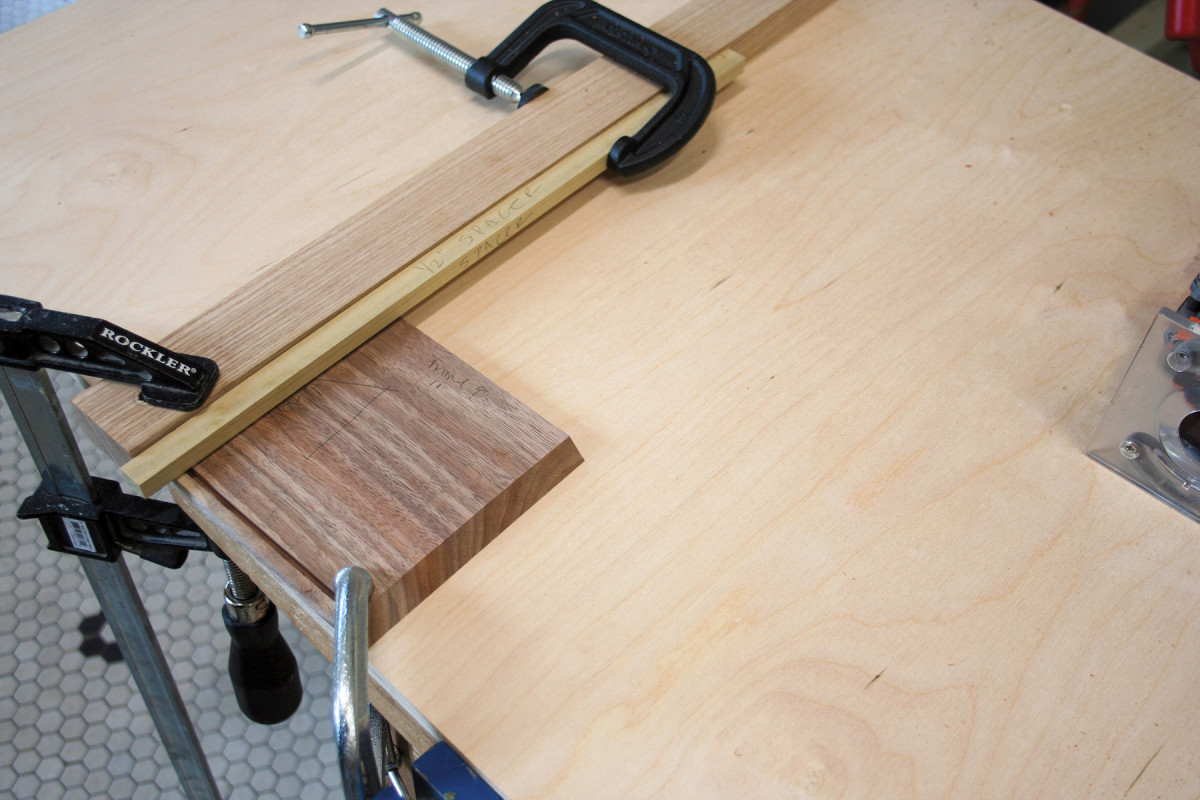
7-9. Using a router to cut the 1/8″ wide dadoes takes a little clever jigging on sides that are already mitered. I use a straight fence to register the mitered edge. Then, I ripped a thinner piece of wood that covers the miter. That’s the piece you’ll fine-tune to make sure your router base has a good reference and lines up with your dado layout. You’ll mirror this operation for the other side.
Set the saw to 45°. Cut one side of each piece to 45°, taking care not to cut off more than necessary but not leaving a flat edge uncut. Set a stop block to cut the last side to 7“, marking your piece at the correct length and slowly testing your cuts until you get to the right size. Cut both the top and bottom before moving the stop block. Repeat this step for the sides at 5“.
 Tape the box together to test the fit and to measure the inside dimension. Lay out each piece facing down and line up the top edges with a straight edge. Put two pieces of masking tape on each corner seam, making sure the bottom groove is lined up correctly on the inside. Gently fold the box into itself and tape the last seam to close. Test the fit of your box; the corners should come together forming a 90° angle with no gaps along the seam.
Tape the box together to test the fit and to measure the inside dimension. Lay out each piece facing down and line up the top edges with a straight edge. Put two pieces of masking tape on each corner seam, making sure the bottom groove is lined up correctly on the inside. Gently fold the box into itself and tape the last seam to close. Test the fit of your box; the corners should come together forming a 90° angle with no gaps along the seam.
 Measure the inside dimensions of your box—it should be 61/4“ wide by 41/4“ high by 43/4“ deep. If your box ended up being smaller than this, you will have to recalculate the size of your back and shelf pieces. Take the piece milled at 1/8“ and cut it to the final dimensions of 69/16“ x 49/16“ for the back piece and 69/16“ by 43/4“ for the shelf piece.
Measure the inside dimensions of your box—it should be 61/4“ wide by 41/4“ high by 43/4“ deep. If your box ended up being smaller than this, you will have to recalculate the size of your back and shelf pieces. Take the piece milled at 1/8“ and cut it to the final dimensions of 69/16“ x 49/16“ for the back piece and 69/16“ by 43/4“ for the shelf piece.
Routing the Shelf Dado
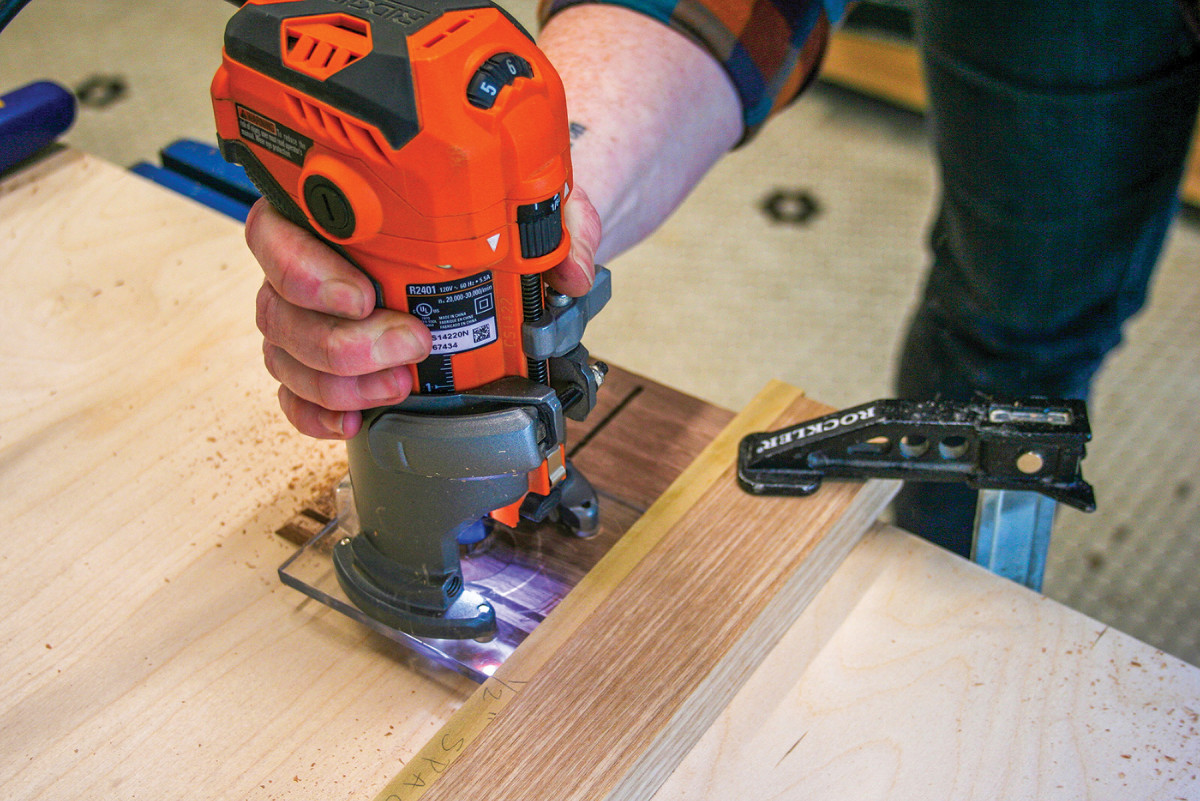
10. Rout out the bulk of the dado, stopping just shy of your end mark.
Label each piece of the carcass, noting the top, bottom, left and right sides. On the sides, label the front edge and the top edge. Make a pencil mark at both 113/16“ and 115/16“ down from the inside of the top edge. Set a marking gauge and mark 1/4“ in from the front edge at the point it intersects the pencil marks. This is where we will cut the stopped dado for the shelf piece.
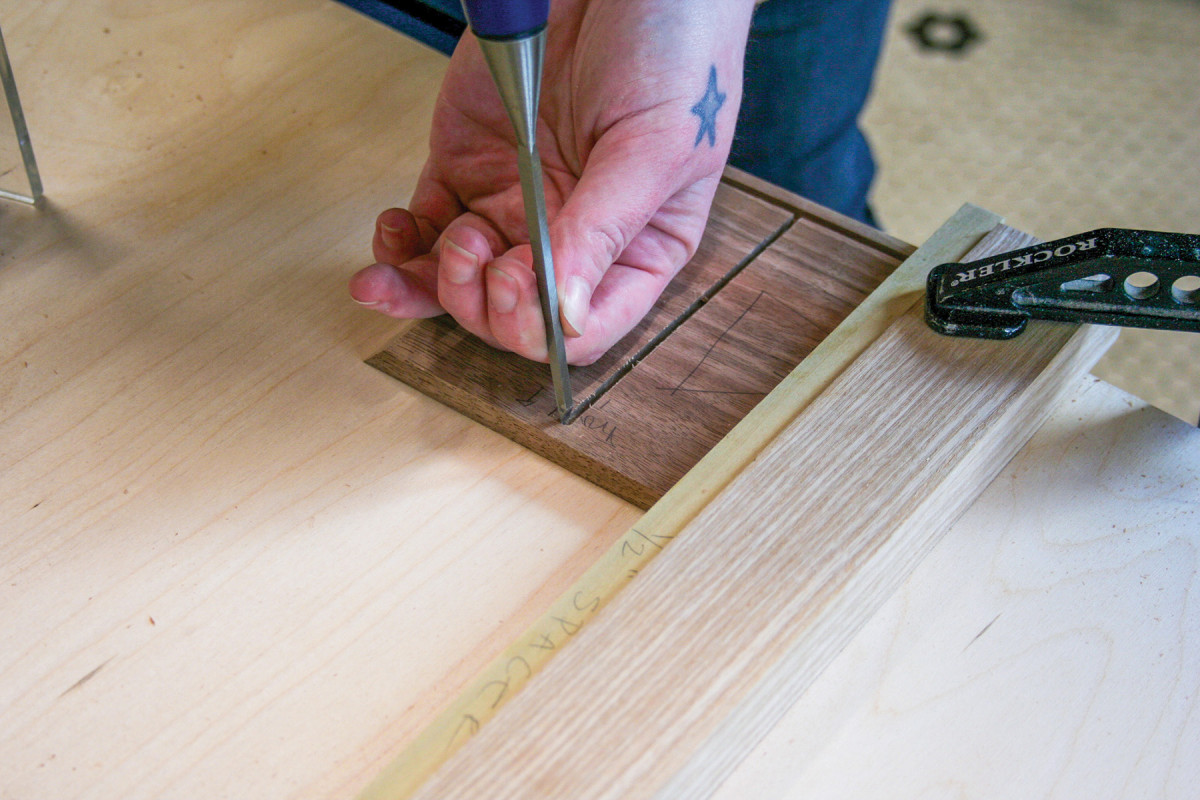
11. Square up the ends of the dadoes with a chisel.
For these small boxes, I prefer to work with a handheld trim router and set up a jig so that the workpiece is facing me. In the setup picture on page 41, I have clamped a long, straight piece of wood to the edge of a table to act as a fence.
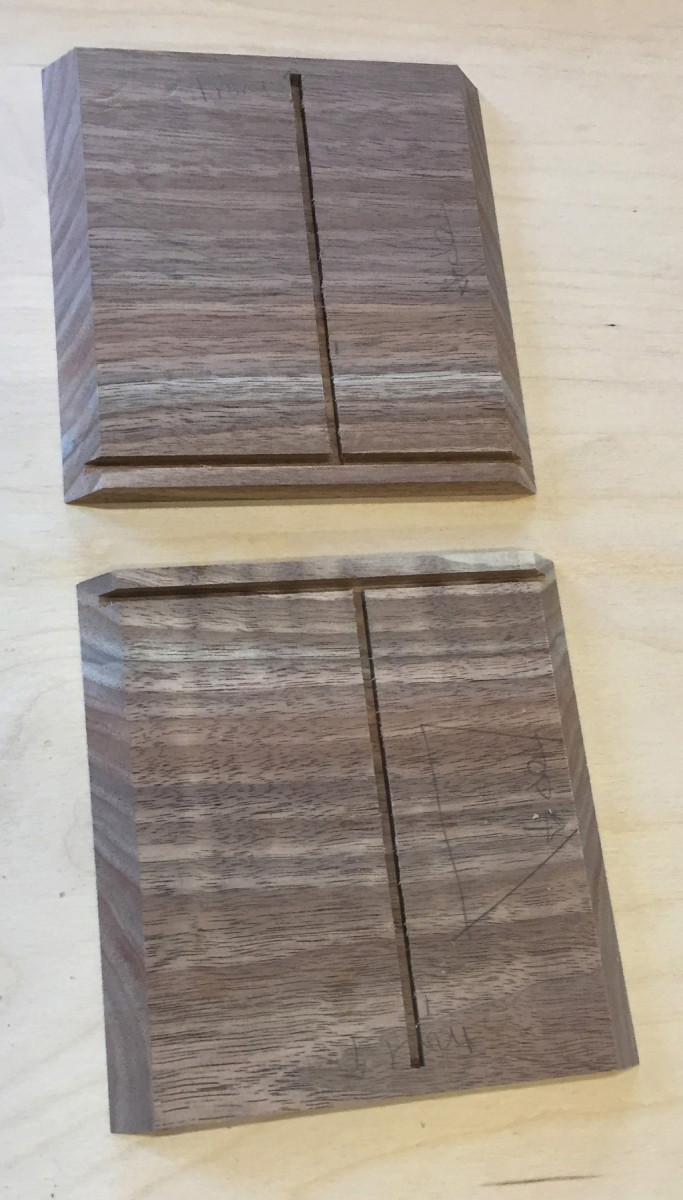
12. You should have two mirrored sides, with the stopped dadoes toward the front of the box.
After testing a few different layouts on scrap wood, I found a 1/2“ spacer gave me the right distance to work with the base of my handheld router. Use a c-clamp that clears the router or woodturner’s double-sided tape to secure the work piece down. The depth of the cut should be about the same as the depth of the groove for the back piece (which was 1/8“ deep).
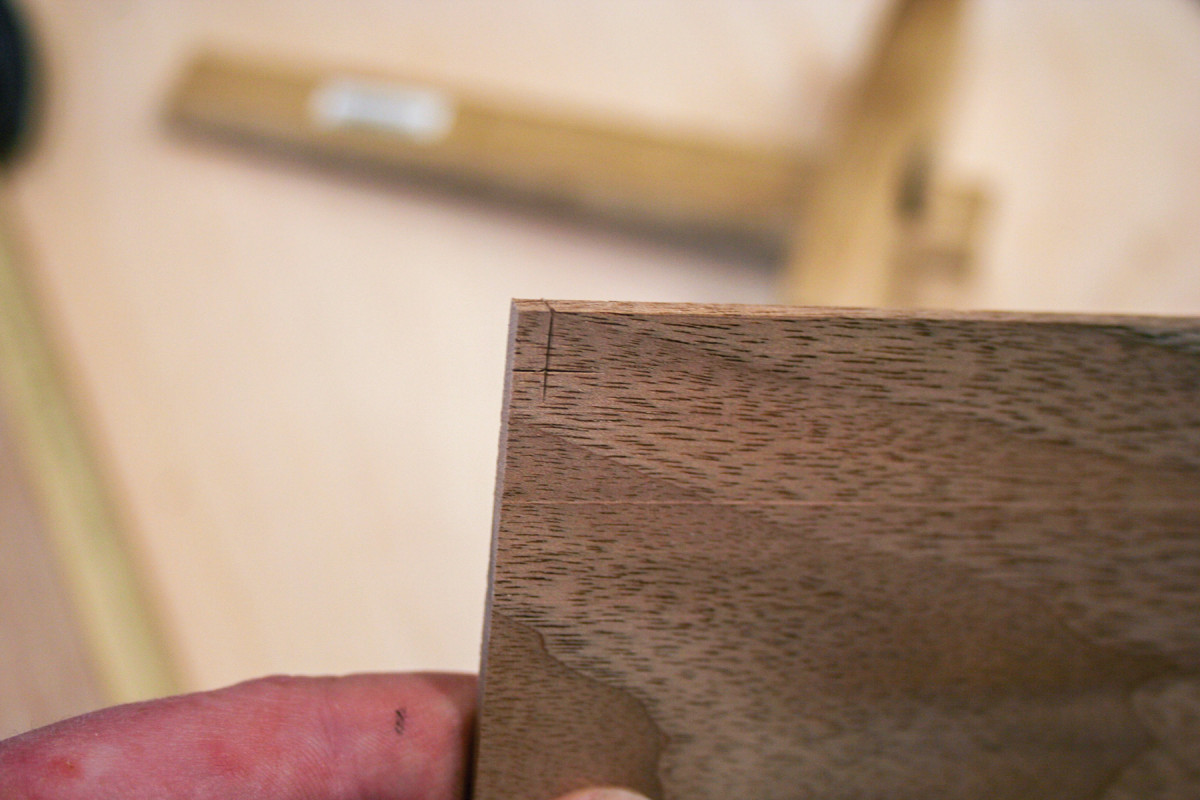
13. Mark and cut out the two corners of the divider so that it fits in the stopped dado.
Test the cut on a piece of scrap wood before cutting your material. Cut the dado in both side pieces, one at a time. Be sure to hold the top edge against the fence each time.
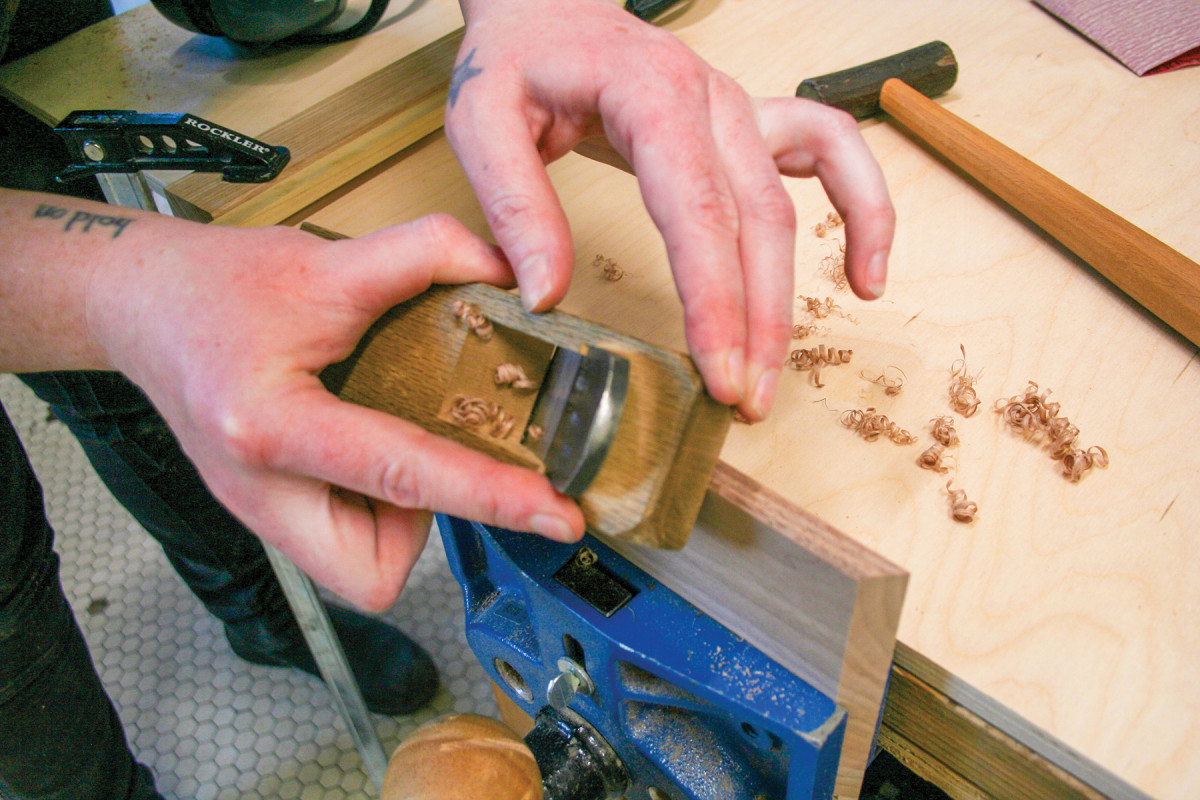
14. Before assembly, I give the inside front edges of the sides and top/bottom a small chamfer with a plane.
The dado should end at the marked line 1/4“ in from the front edge and at the groove for the back on the opposite edge. Drop the running router bit into the wood while holding the front edge against the fence. Go slowly and be sure you are cutting into the blade.
Fitting Stopped Dado
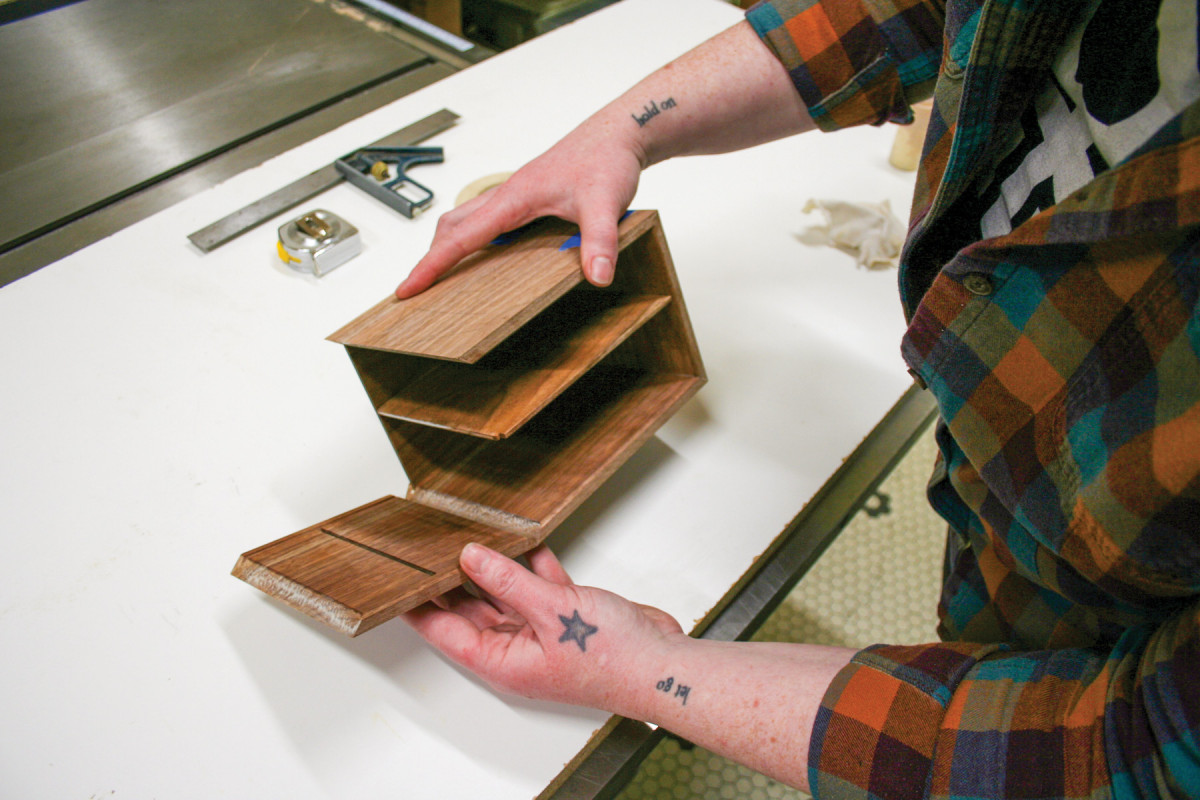
15-17. With small boxes like this, tape is usually all the clamping I need. I do a dry assembly first to make sure all the miters fit nicely. I also use this as an opportunity to fine tune the fit of the back and shelf, making sure to allow a little wiggle room for wood movement.
Square off the round edges of the dado with a small chisel. On the shelf piece, use the previously set marking gauge to mark 1/4“ in from the front edge down along sides of the shelf piece and then 1/8“ along the face to cut a notch out to fit into the stopped dado.
Chamfering Inside Edge
 Using a pencil or a marking knife set to a shallow cut, mark along the grain 1/16“ in from the front and inside edges of all four carcass pieces. Use a handplane to chamfer the inside edge of the box, removing the material between these two marked lines. These chamfers should line up in each corner with no uneven sides. Plane the front edge of the shelf piece to the point where it meets the new chamfer on the sides.
Using a pencil or a marking knife set to a shallow cut, mark along the grain 1/16“ in from the front and inside edges of all four carcass pieces. Use a handplane to chamfer the inside edge of the box, removing the material between these two marked lines. These chamfers should line up in each corner with no uneven sides. Plane the front edge of the shelf piece to the point where it meets the new chamfer on the sides.
 Test the fit of the back and shelf pieces by re-taping the box together.
Test the fit of the back and shelf pieces by re-taping the box together.
Carefully check the fit, ensuring that the mitered edges still close without bulging out and there are no gaps in the corners. Keep wood movement in mind, the back piece should have a bit of space to swell and move along the grain. We don’t want things too tight.
Gluing the Carcass
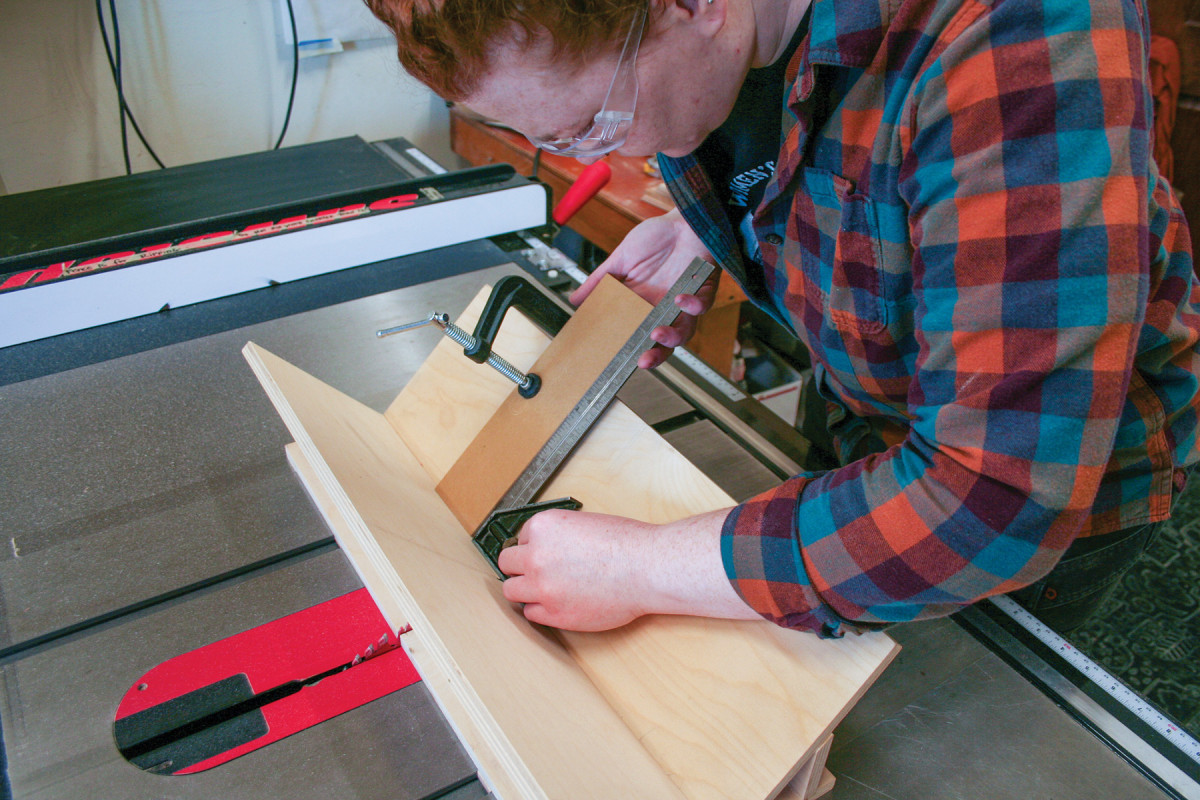
18. After the glued up case has time to set, it’s time to cut the splines. I do that with a cradle jig on the table saw.
Sand the inside of the carcass pieces before gluing it together. I like to put a light coat of oil/wax mixture on the inside surfaces before glue-up because the finish resists glue and makes it easier to wipe away squeeze-out on the small inside pieces.
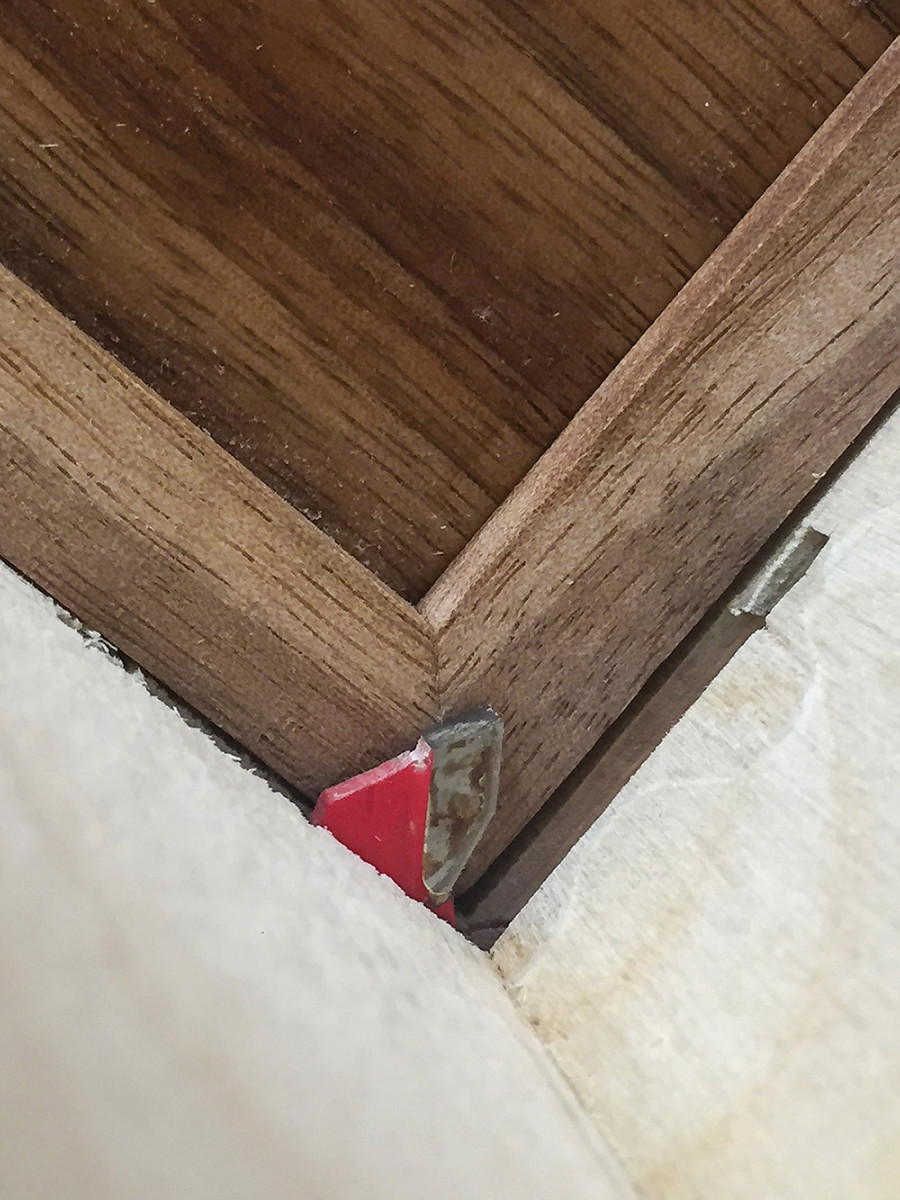
19. Set a flat-topped blade to cut 1/2″ deep into the corner of the box.
Do not get finish on the miter joint edges or inside the grooves as the glue will not stick. Alternatively, you could lay a piece of masking tape on the wood just where the seams will meet, to catch any glue squeeze-out.
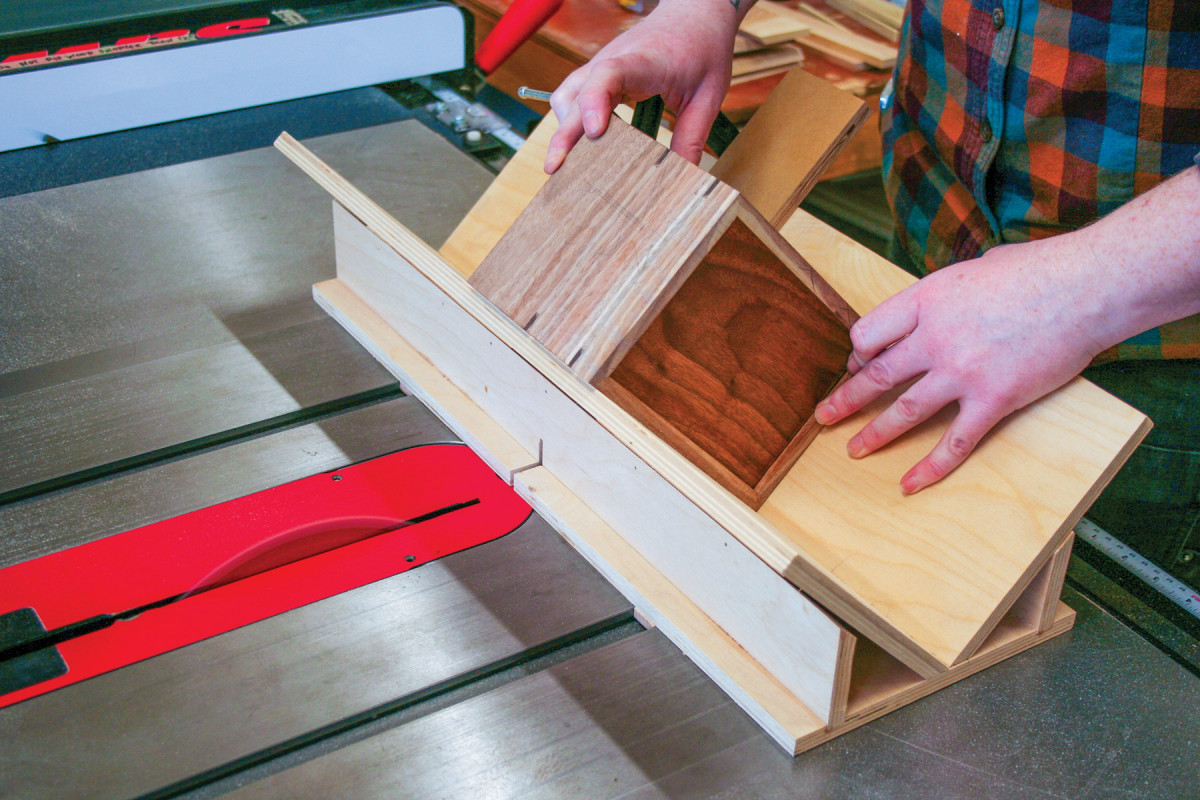
20. I cut the middle splines first, then adjust the fence for the outside splines.
Get everything in place before you start spreading your glue. Have your tape ready and your wet rag on hand. As before, line up your pieces using a straight edge and tape the backs together, then flip it over and use a paintbrush or your finger to spread a generous amount of glue into the miter joints.
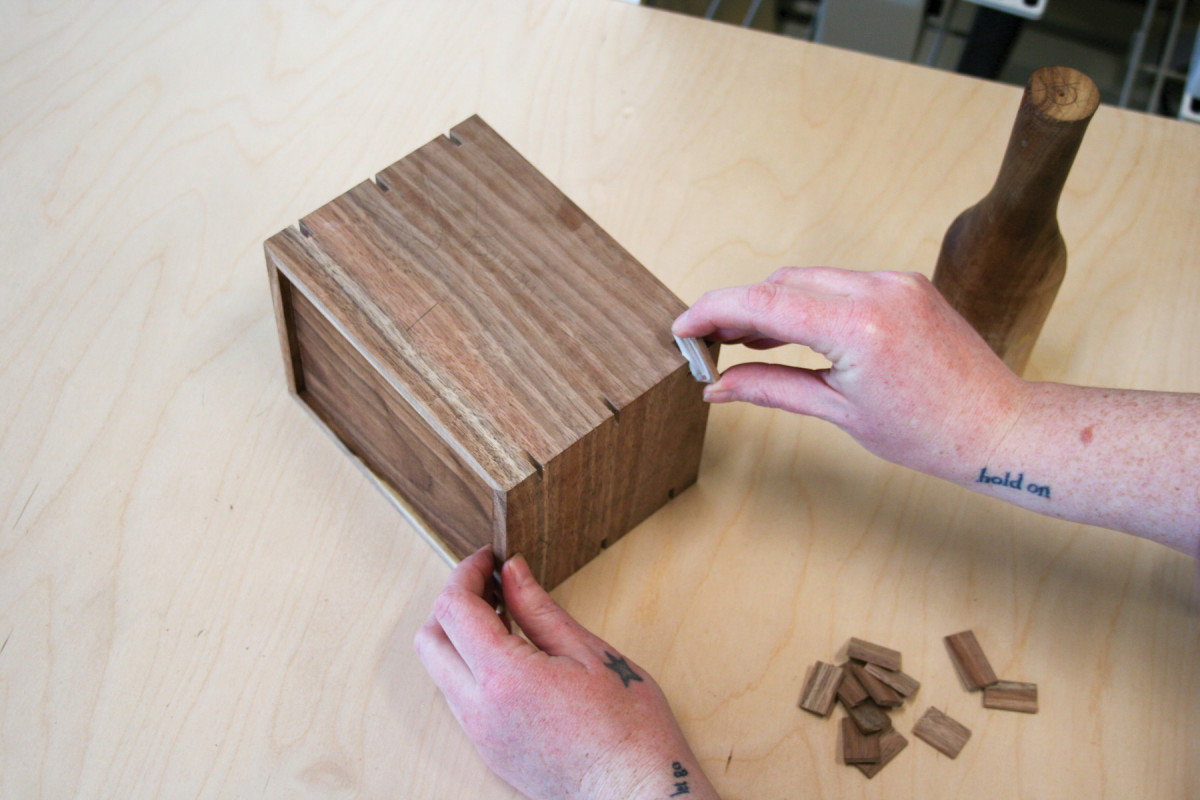
21. Test fit the spines for fit, then glue them in place.
Do not put glue in the dado for the back piece, and you don’t need a lot of glue in the shelf dado. Fold the box into itself, making sure to put the back and shelf pieces in as you do. Use a wet rag to wipe away the glue from the inside seams. Put two or three pieces of strapping tape along each mitered seam and check everything for square. Now, do not touch or move your piece while the glue dries!
Cutting the Splines
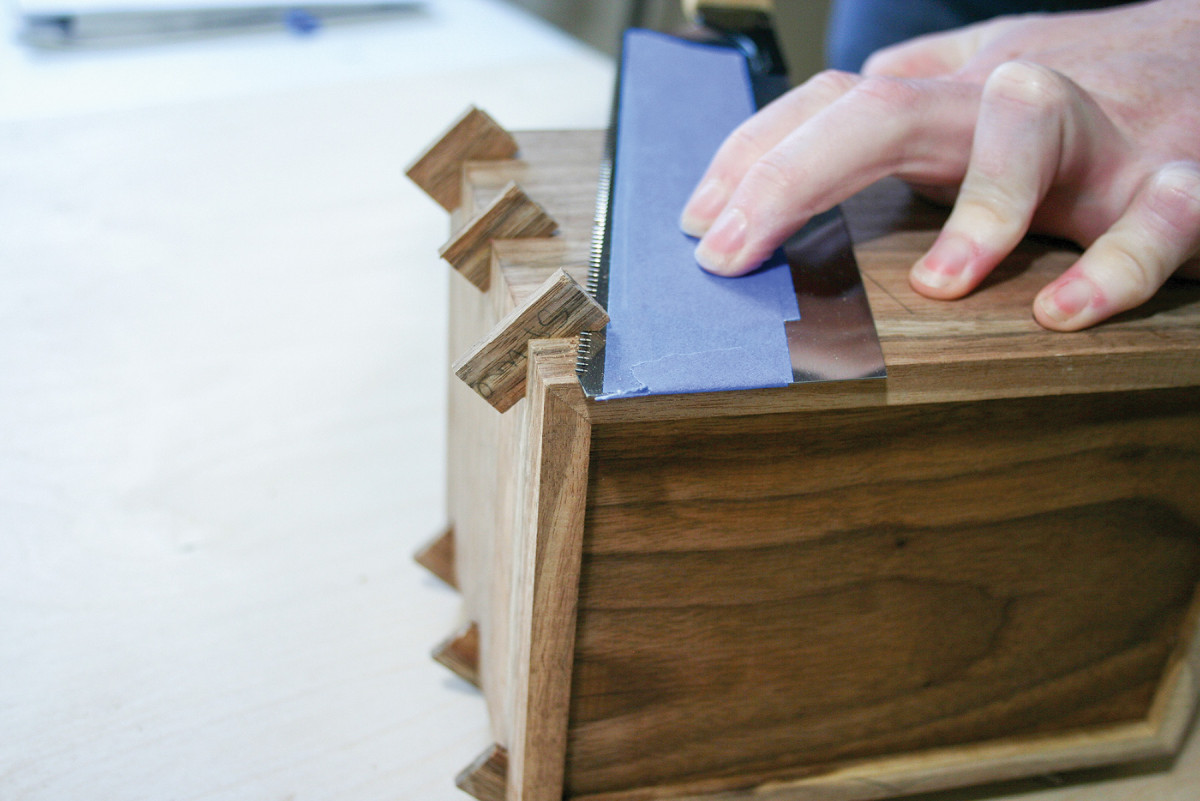
22-23. Cut the splines flush. A bit of tape on my saw raises it just enough to protect the box from saw marks.
Once the glue has set (I usually wait at least 2-3 hours or more), you can cut the grooves for the splines in the carcass piece. Use a spline jig and a flat-topped table saw blade to cut the three splines in each side.
 Use a piece of scrap wood to test the height of the saw blade using the spline jig. The height of the blade determines the length of the cut, which should extend 1/2“ from the corner on either side.
Use a piece of scrap wood to test the height of the saw blade using the spline jig. The height of the blade determines the length of the cut, which should extend 1/2“ from the corner on either side.
Mark 3/4“ and 7/8“ from the front edge and line up the table saw blade between those two marks. Set a stop block here and cut four splines at this dimension, making sure to check your stop block for square against the spline sled. Keep the front edge along the stop block and turn the box after each cut until you have cut all the way around the box.
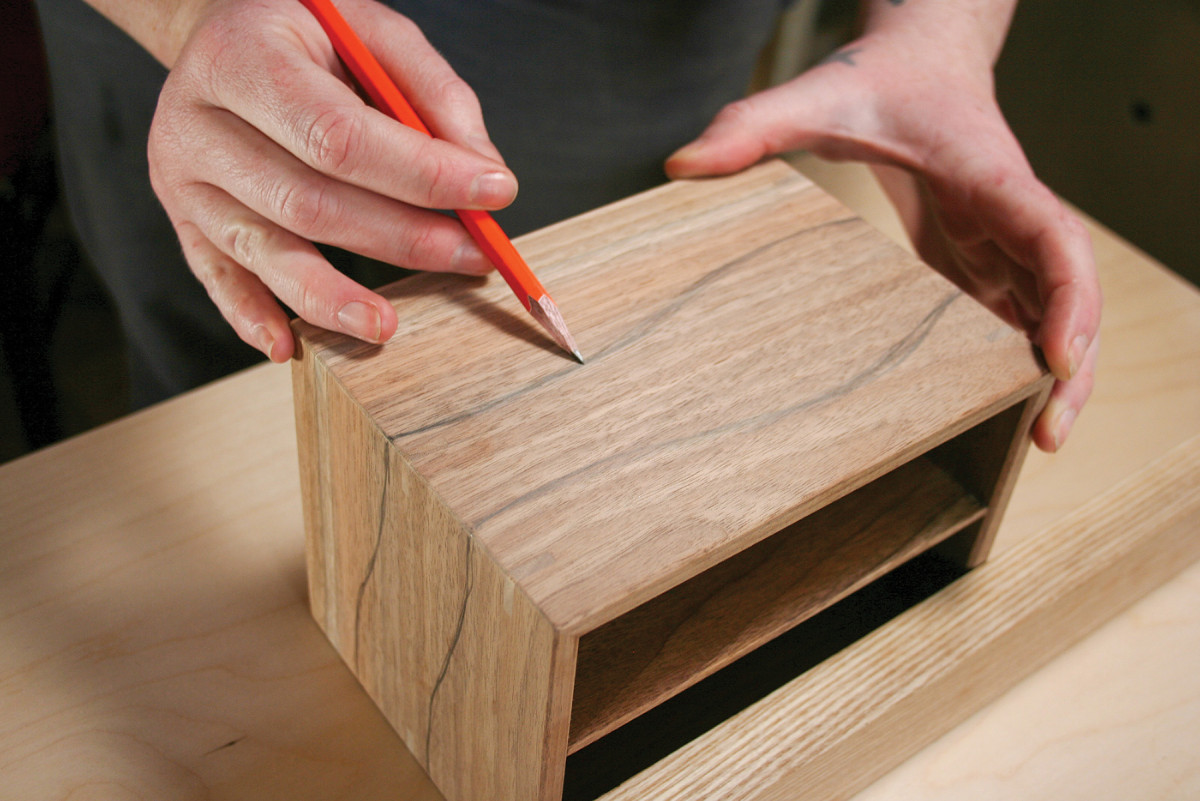
24. Lay out the pattern for the texturing in pencil. I aim for something organic and interesting that plays off the grain of the box.
Flip the box around and use the same stop block to cut the splines using the back edge of the box against the stop block. Repeat the process until you have a total of eight spaces for splines. Mark 1/16“ from either side of the center and again line up with the saw blade and set the stop block to cut the center spline grooves.
Gluing the Splines
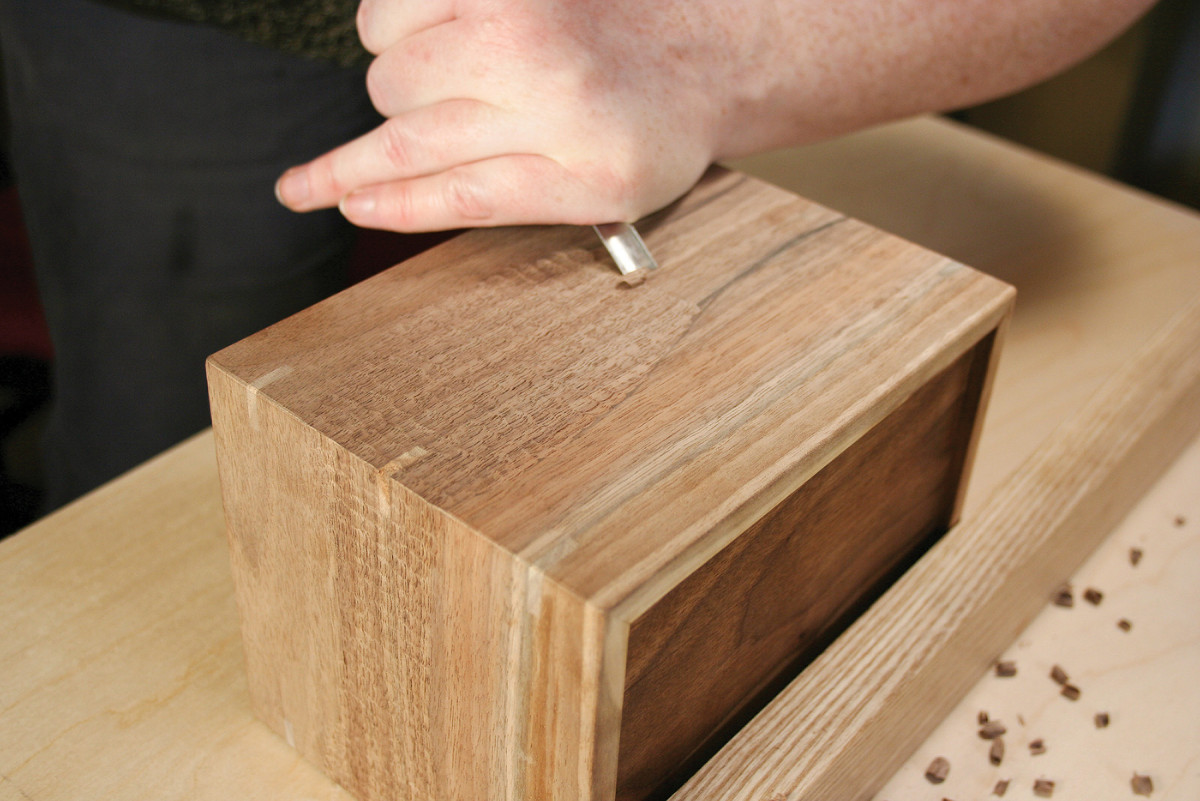
25. After some test cuts on scrap, gently clamp the box to your bench and start cutting the texture. I use a sharp gouge and use slow, steady motions.
Take your piece of 1/8“ material set aside from making the back and shelf piece and test it’s thickness against the grooves. It should be a snug fit but you should be able to get it in and out at this point without too much effort. The pieces will swell a bit with the glue.
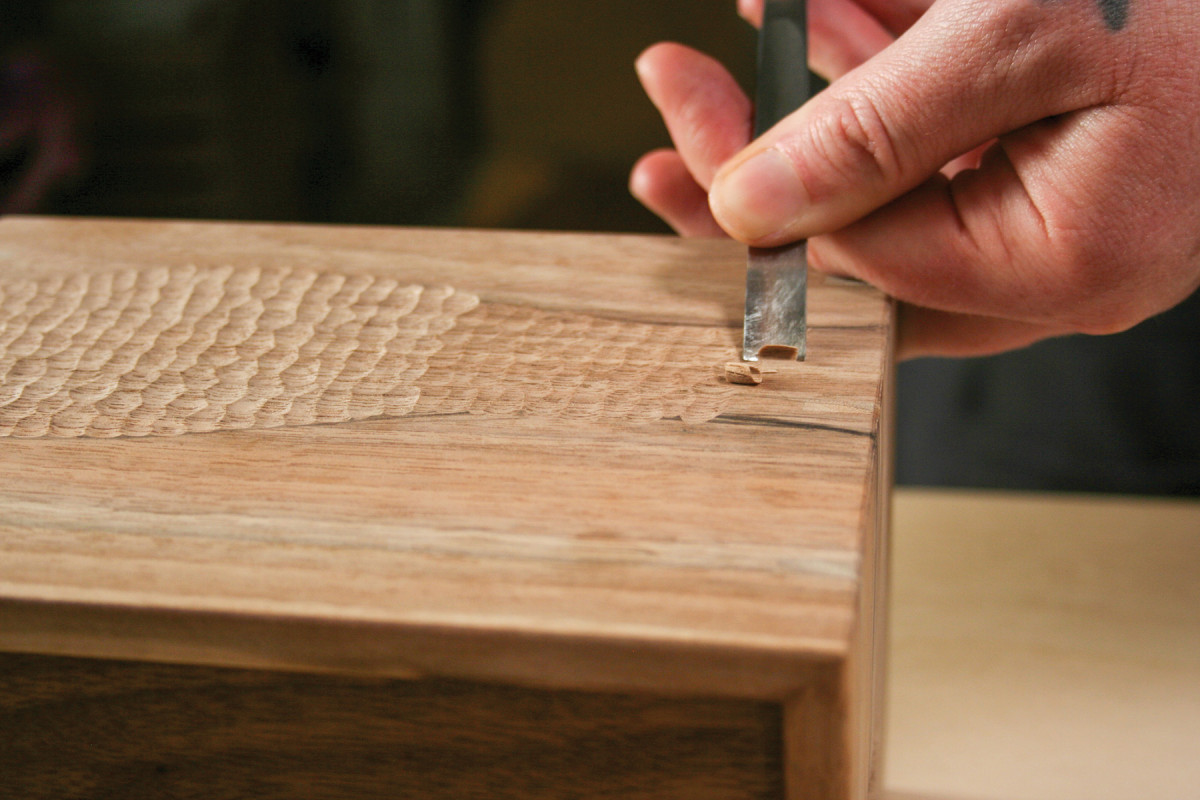
26. As you work your way through, be methodical and try to take the same level of cut each time.
Crosscut the spline stock small sections using the bandsaw or a handsaw. Prepare extra spines in case any break or drop on the floor while gluing up. Use a small paintbrush to brush wood glue into the inside of the spline grooves and onto the splines and gently tap each piece into place, making sure that each piece is fully seated at the bottom of the groove. Wipe up any excess glue on the outside of the spline joint and check for gaps in both sides of each spline.
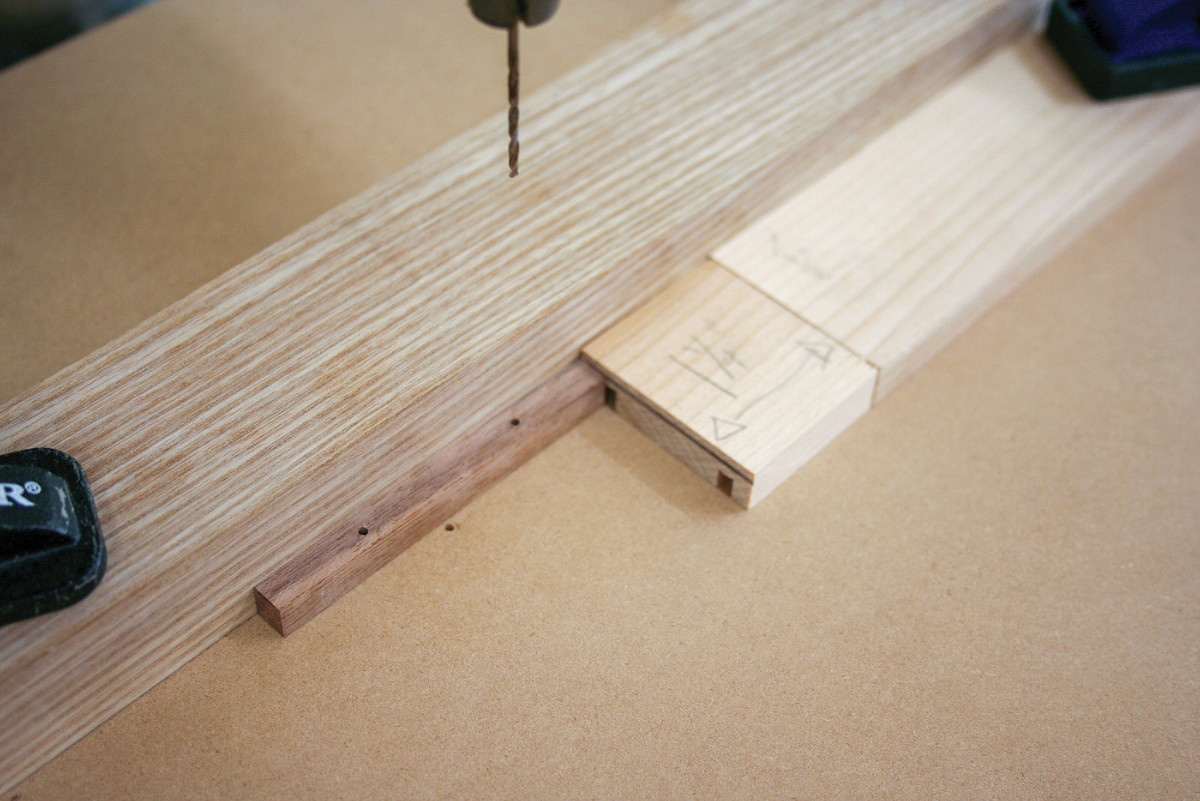
27. The handles for the drawer boxes are pre-drilled for a bit of brass rod to be used as standoffs. I use a drill press for this delicate work.
Set aside to dry for an hour or so before using a flush-cut saw to trim the excess. If you don’t have a flush-cut saw, you can run a piece of masking tape along either side of your saw so that the teeth won’t dig into the box while cutting off the splines. Cut the corner part first so the delicate end grain doesn’t pop out there.
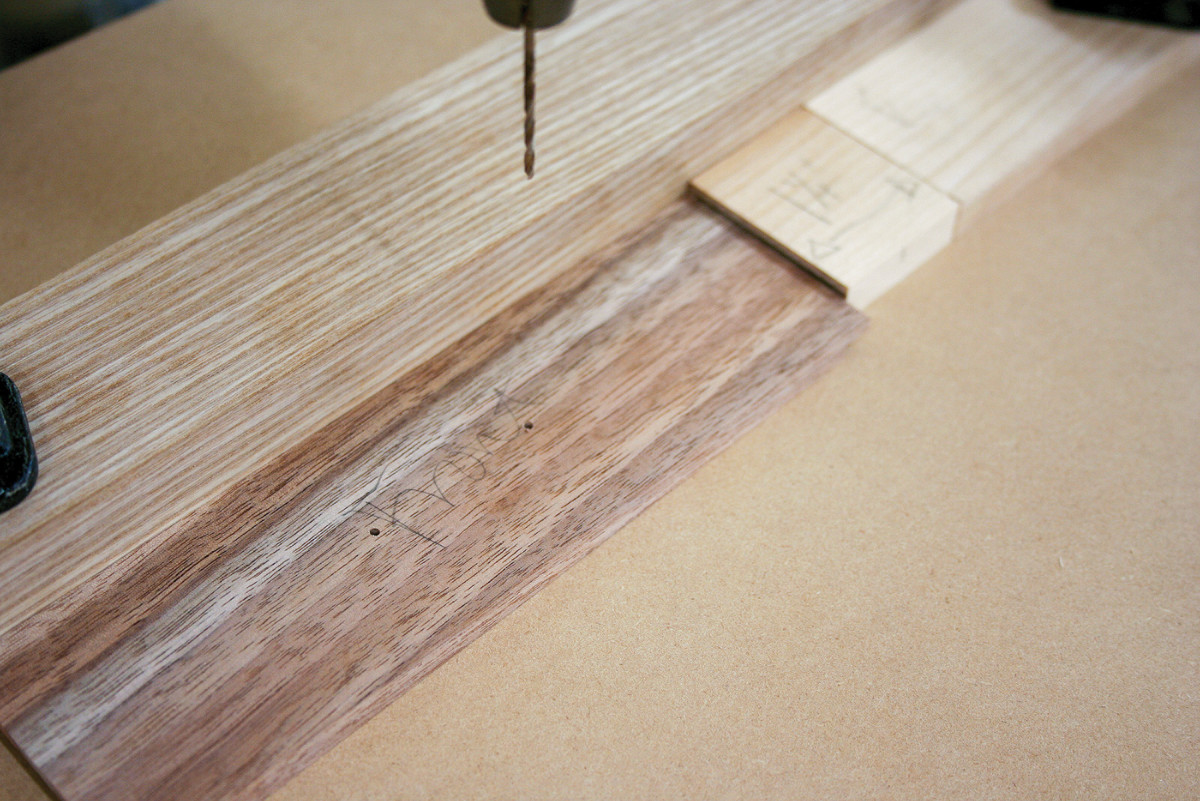
28. Repeat for the drawer fronts.
Now you can sand or scrape the outside of the box and prepare for carving. The box should be sanded to 320 and then dusted off or planed and scraped.
Carving the Outside
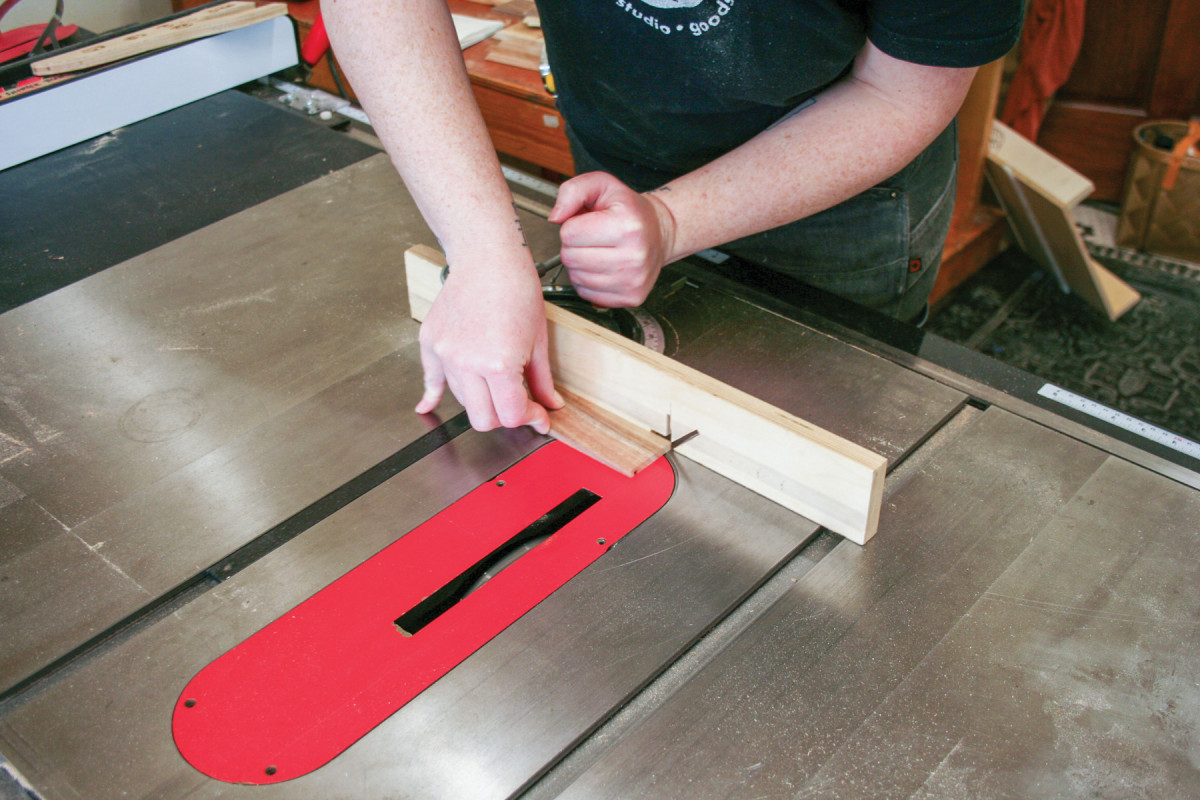
29. The boxes are joined with rabbets. I use a dado stack and miter gauge to cut the rabbets. The top drawer is completely open, but I added dividers to the bottom drawer, held in place with dadoes.
When drawing out the area for the decorative carving, I like to do a few carving samples on scraps of wood and look at the patterns against the nearly-finished box. I freehand draw directly on the box the area that I want to carve, stepping back often and looking at the box from multiple angles until the balance feels right.
Gently clamp or wedge your box onto your bench so it does not move around – you can put rags or white Scotch-Brite pads inside the vise jaws to prevent scratching. Use a sharp #5 or #7 gouge to create the scalloped texture decoration. Hold the tool in your right hand and brace yourself against the work surface with your left arm, holding your right hand with your left. Move in slow, steady motions—try to create a rhythm that will help your hands automate moving the same distance and taking the same size scoop with each step.
Move the blade’s edge across the surface in a left-to-right slicing motion as well as a front-to-back cutting motion to achieve the cleanest cut. Each scoop should be one movement of the gouge to keep things the same size. Move in rows, finishing one linear row before going to the next, overlapping the circular scoops of the gouge to create hexagon shapes.
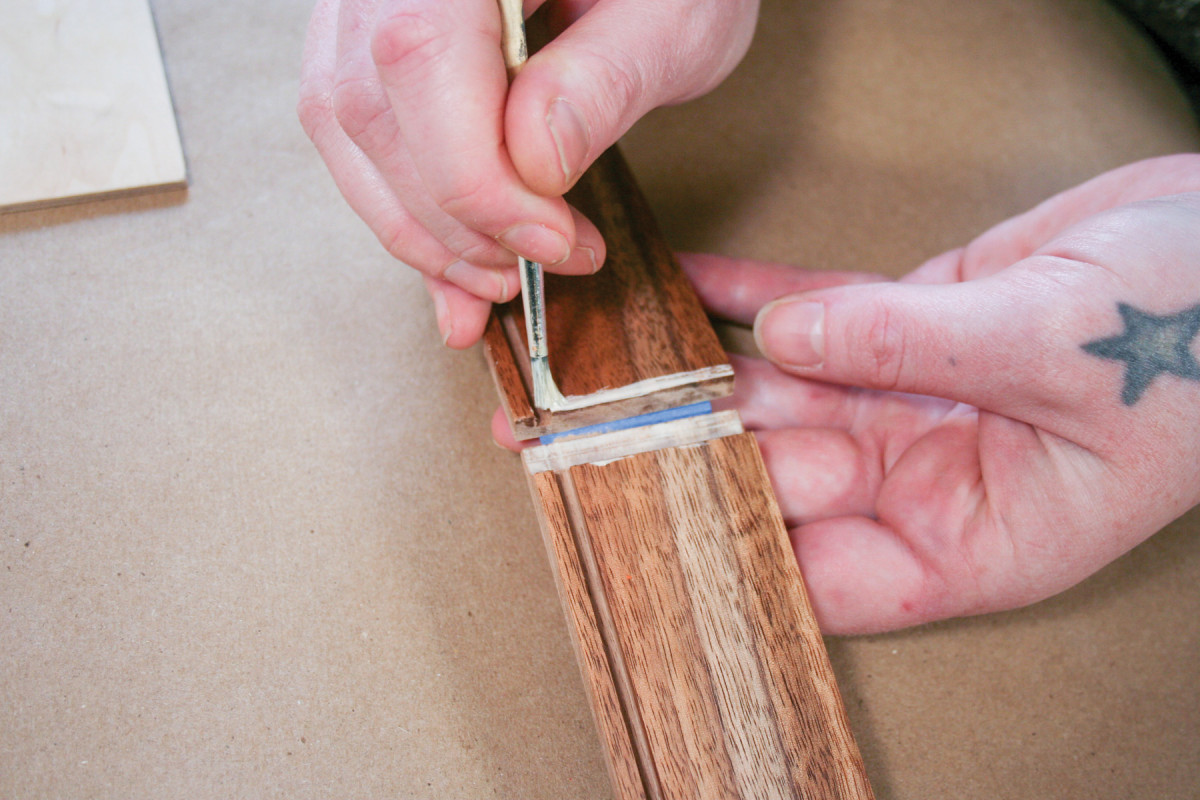
30. Fit the drawer bottom and glue up the drawers. I prefinish the interior of the drawers, making sure to tape off any glue surfaces.
Carry the lines around to the other sides of the jewelry box to continue the carved pattern around the sides. You don’t necessarily have to do the whole bottom surface, but I like to carve an inch or two onto the bottom for a little surprise for attentive viewers.
Keep your tools sharp and strop often. A sharp blade and a steady, shallow cut will leave a smooth surface that will not require any additional finishing. A dull gouge will leave streaks in your scallops and a rough surface. Be consistent with your pressure, depth of cut, and distance between cuts for an even pattern. Use caution around the mitered corners and the end-grain splines. Once the carving is complete you can lightly buff the surface with a white Scotch-Brite pad to knock down any edges and smooth out the carving.
The Drawers
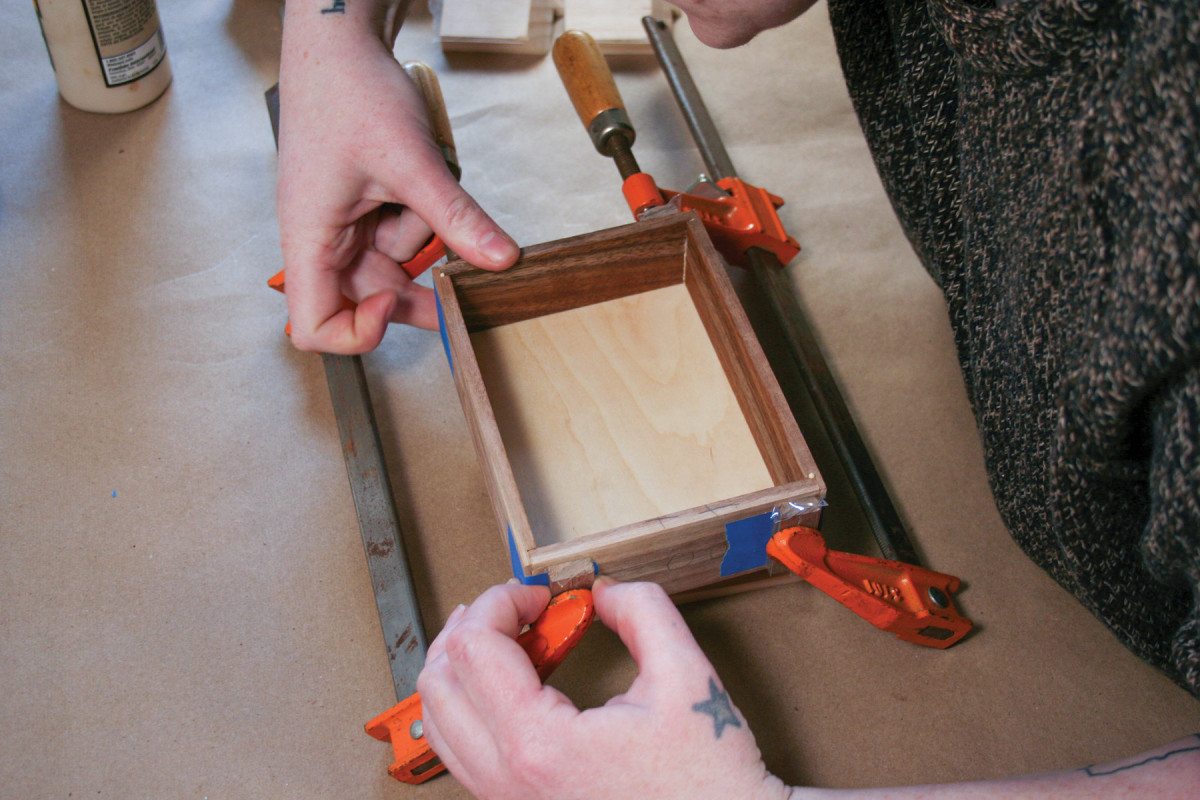
31. When clamping the drawer, keep in mind too much clamping pressure can warp these small parts. Use only enough to draw the joints tight.
Mill your drawer stock to its final 1/4“-thick dimension and widths of 113/16“ and 21/4“. You will want to test fit the height of your drawers with scrap wood to ensure there is about 1/32“ of space between the top of the drawer pieces and the inside of the box. Allow enough room for the wood to move over the seasons.
While the pieces are still at their 20“ length, cut the groove that will capture the drawer bottom. Carefully lay out your pieces and label the outside faces and the bottom edges, and decide which piece will be the drawer fronts.
Since we are using 1/8“ plywood for the bottoms we will use one pass on the table saw to cut the groove. Set the table saw fence to 5/32“ and the height of the saw to 5/32“ and test both settings on a piece of scrap wood from the drawer stock. Cut a groove in the bottom of both drawers.
Set up the table saw miter sled to cut the drawer parts to lengths listed in the final cut list. (63/16“ and 45/8“) Carefully measure the inside of the carcass at this time and tweak the measurements as necessary. We want to leave about 1/32“ of space on either side of the drawers and at the top edge to allow for wood movement. Use these margins to determine the size of your drawer parts. If you are correctly following along with these dimensions, your parts will be 63/16“ x 41/2“.
The drawer joinery details are shown on above; take note of how this will go together before starting to cut your drawers apart. Cut your first end square, and then use a stop block on the miter sled to cut all the drawer parts of the same length at once (that’s four at each length). Be sure to have some excess material for testing later on.
Next, rip the pieces for the drawer pulls and the feet. You should be able to get this from the scrap you’ve accumulated. You need two pieces at 1/4“ x 1/4“ x 23/4“ for the drawer pulls and two pieces at 1/4“ x 5/8“ x 4“ for the feet.
Drawer Joinery
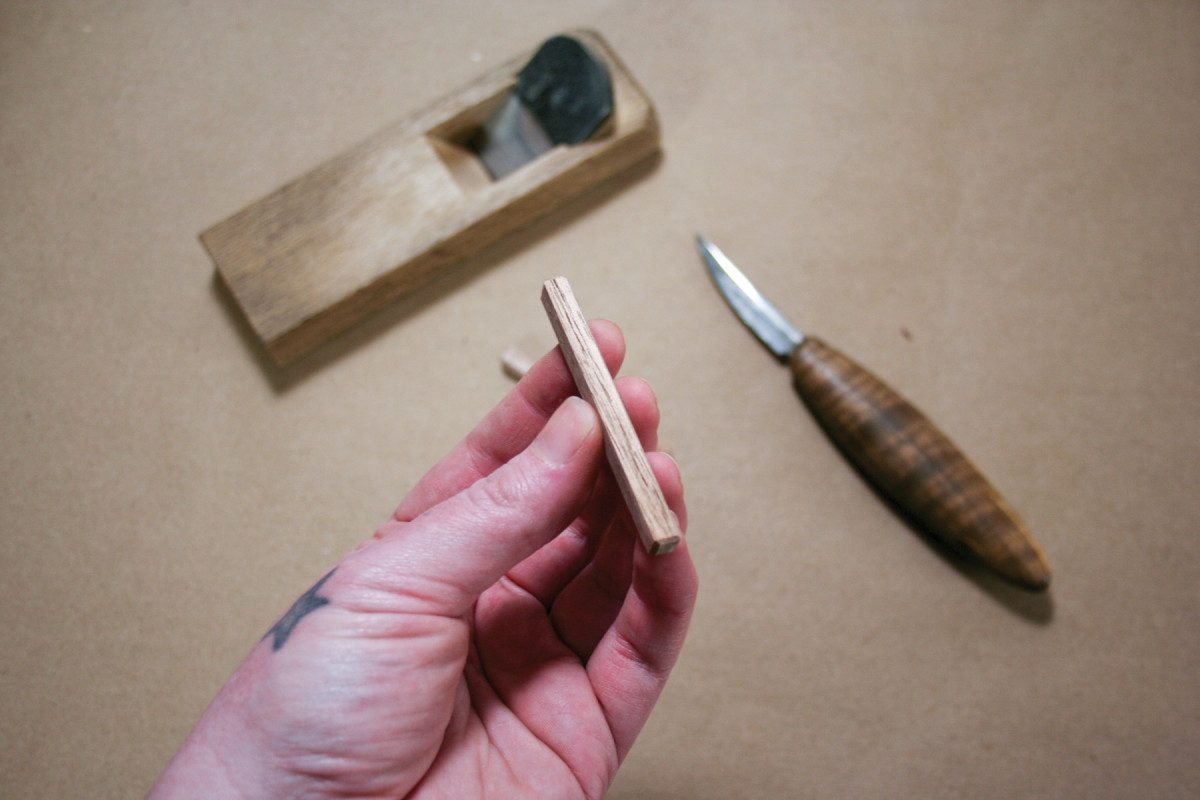
32. I use a carving knife to add a little detail to the drawer pulls, reinforcing the organic shapes of the jewelry box.
Set up a 1/4“ dado blade on the table saw to cut the rabbet joints for the drawer sides. The height should be set at 3/16“. Set up a stop block on the right hand side of the miter sled so that you are cutting 1/4“ off of the sides of the 63/16“ pieces. Test the settings with a piece of scrap wood from the drawer stock. Cut both sides of both drawer front and back pieces, eight cuts in total.
Now you should be able to fit your drawer pieces together using masking tape and test the fit into the carcass. Fold over a piece of masking tape and leave it sticking out of the drawer to use to get the drawer in and out since there are no pulls yet. The drawers should fit with just a bit of wiggle room without large visible gaps at the sides but should not take effort to push in. We’re looking for close to 1/32“ of space between the sides and top. Remember that the tape is taking up some of the space and that you can always take a handplane to the sides after glue-up if it is too tight or glues up out of square.
Once you have test the fit of the drawers and made any corrections to your cuts, you can determine the size of the bottom panels. The bottoms will be the inside dimension of the drawer plus 1/4“. Mine measure 515/16“ x 43/8“. I prefer to finish drawer bottoms before glue-up, so at this point I am moving to the finishing room to finish and flock the drawer bottoms. I have also sanded and finished the inside of the drawers before glue up, taking care to not finish any part of the rabbet joint that will be glued.
Drawer Dividers
The optional drawer dividers are made from 1/8“ stock milled earlier in this process. The height of the drawer dividers should be the same or just under the height of the inside of the drawer. This should be a height of 11/2“ for the top drawer and 115/16“ for the bottom drawer.
We will use the same process with the handheld router that we did to cut the dado for the shelf piece in the carcass. Setting up a jig to cut the between 17/8“ and 2“ from each edge of the long drawer sides to divide the drawer into three widths. Stop the cut 1/4“ from the front edge and cut the divider piece to create a stopped dado that is invisible from the top of the drawer. Repeat the cut on the bottom drawer to create two asymmetrical rectangles.
Drawer Pulls
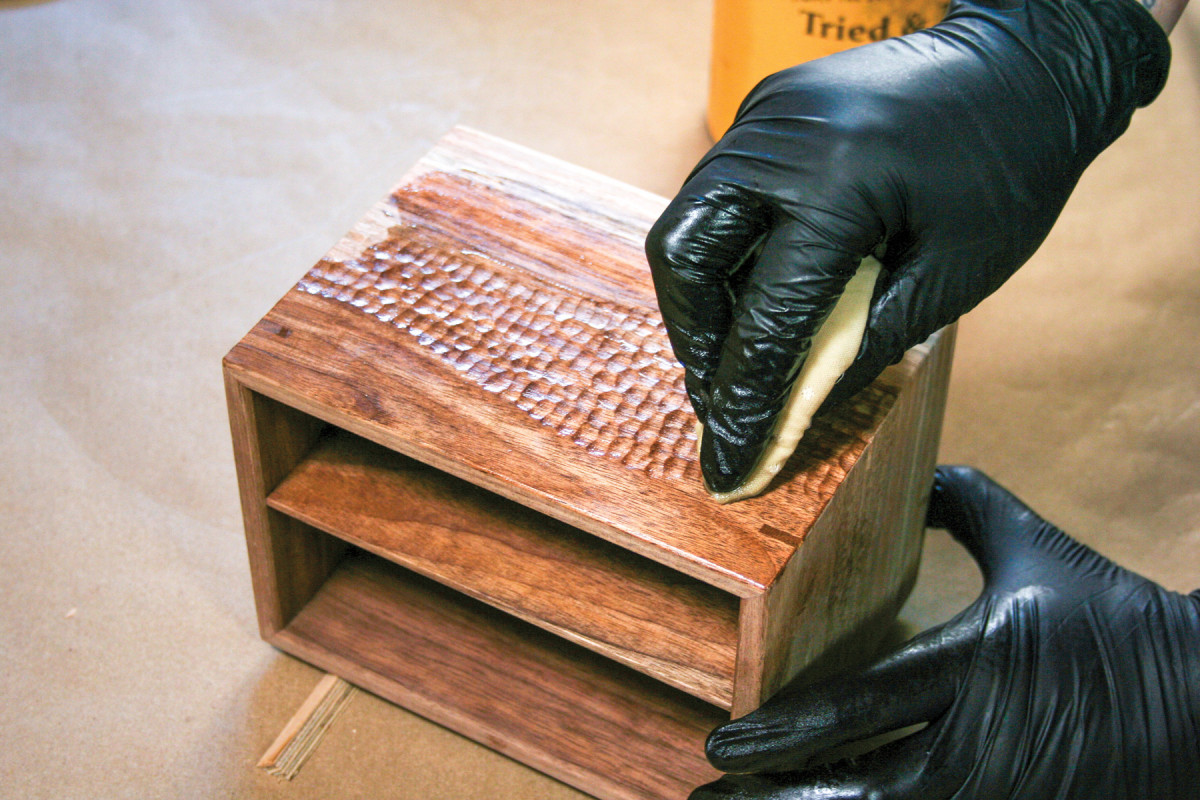
33. Apply finish to the outside of the box. I used Tried and True Danish Oil.
Before gluing up the drawer fronts, we will mark and drill two holes at 1/16“ diameter by 1/8“ deep for each drawer pull. Have your drawer pull stock ready so you can drill both sets of holes at once. Set up a stop block on the drill press so that the first hole is drilled at 3/4“ away from the side of the piece and in the center along its width. Make a 11/4“ long spacer from scrap wood to drill holes in both the drawer fronts and pulls exactly the same distance apart. Drill the first hole in the drawer front using the stop block, and then use the spacer to move the piece over 11/4“ to drill the second hole. Drill the holes in the drawer pulls in the same way, drilling the first hole with the stop block then using the spacer against the stop block for the second hole.
Drill these holes slowly as to not allow the thin drill bit to bend, and set a stop or use a piece of tape on the drill bit to ensure you do not drill all the way through either hole.
Sand and finish your drawer pulls. I like to use my carving knife to facet the edges of the drawer pulls and carve a bit of the back off for a nice grip for your fingers.
Using a hack saw or wire cutter, cut four pieces of 1/16“ polished brass rod to 3/8“ lengths for the drawer pulls. Buff the brass with fine scotch-brite pads before cutting to length. I prefer to glue on pulls after the drawers have been finished or at least glued up, but you may do so at any time.
Drawer Assembly
 Once all of your drawer parts are ready, it is time to glue up. Get everything you need ready and test all of your clamps dry before gluing, including a wet rag and wooden cauls so the clamps don’t bruise the wood. In the same manner that we glued up the carcass, we will use wood glue over the rabbet seams and avoid getting glue into the groove for the bottom. Be sure to get enough glue on all the surfaces of the rabbet joint and clamp together with the bottom piece and optional drawer dividers in place. I used four clamps on the top drawer and eight clamps on the lower drawer. Check the drawers for square using a small square or by measuring the distance between opposite corners. Wipe away any excess glue with a wet rag and allow it to set for several hours. At this scale the glue joint is strong enough so I don’t pin the rabbets.
Once all of your drawer parts are ready, it is time to glue up. Get everything you need ready and test all of your clamps dry before gluing, including a wet rag and wooden cauls so the clamps don’t bruise the wood. In the same manner that we glued up the carcass, we will use wood glue over the rabbet seams and avoid getting glue into the groove for the bottom. Be sure to get enough glue on all the surfaces of the rabbet joint and clamp together with the bottom piece and optional drawer dividers in place. I used four clamps on the top drawer and eight clamps on the lower drawer. Check the drawers for square using a small square or by measuring the distance between opposite corners. Wipe away any excess glue with a wet rag and allow it to set for several hours. At this scale the glue joint is strong enough so I don’t pin the rabbets.
The Feet
 Get the two pieces set aside earlier for the feet (1/4“ x 5/8“ x 4“). Cut each end at 45°, setting a stop block to ensure they are both the same length. Drill 1/8“ holes through the feet at 1“ in from either end and centered along the width. Mark 11/4“ in from either outside edge of the bottom of the box and line both feet along these parallel lines. Use two 3/8“ long wood screws in each foot to secure the feet to the box.
Get the two pieces set aside earlier for the feet (1/4“ x 5/8“ x 4“). Cut each end at 45°, setting a stop block to ensure they are both the same length. Drill 1/8“ holes through the feet at 1“ in from either end and centered along the width. Mark 11/4“ in from either outside edge of the bottom of the box and line both feet along these parallel lines. Use two 3/8“ long wood screws in each foot to secure the feet to the box.
If any part of the drawers sticks or is too tight, use a handplane or sanding block to thin the piece until it fits. Use a block plane and knock down the highest edges of the back of the drawer and the sides near the back to leave room for wood movement but keep the drawer face tight.
The drawers, drawer pulls, and feet should all be sanded to at least as high as 320 grit. The box should already be sanded and buffed after carving. Finish the box with your oil of choice; I prefer Tried and True Danish Oil or Wipe-On Poly.
Here are some supplies and tools we find essential in our everyday work around the shop. We may receive a commission from sales referred by our links; however, we have carefully selected these products for their usefulness and quality.








